











Longer nights and cooler weather are the perfect reason to slow down and wrap yourself in the comfort of heartwarming food. Think hot spicy soup, and oven-fresh baking, or a different take on seafood and seasonal fruit. For November, Michael Diacono offers a fresh and flavourful twist on cooler-weather cooking, mixing mussels with mushrooms, prawns with scallops, and serving saffron sauce with fish. Claire Borg brings a pop of colour and seasonal flavour to your table with pomegranates, the jewel of autumn that has represented everything from prosperity to rebirth. Warm up with hot, spicy soup made from seasonal vegetables, or savour the sweet and sour flavours of Tom Kha. On evenings in, bring out the popcorn and crack open the champagne. Andrew Azzopardi has some innovative suggestions for surprisingly pleasing wine pairing. Flip to our interior pages to see the transformation of an abandoned maisonette in a walled city into award-winning architecture, and the regeneration of a Sliema townhouse as a home for a young and growing family. For a window into another world, turn to our feature about A Room with a View, Lydia Cecil’s new exhibition of space-specific paintings, then hop over to Valletta and visit it in person.
We’ll be back in December with our Christmas issue.
If you missed any issue of Taste&Flair and want a copy, we may be able to help so please do get in touch with us by email, Messenger, or on Instagram.


Publisher The Daphne Caruana Galizia Foundation 56 Melita Street, Valletta VLT1122, Malta
Editorial Board
Paul Caruana Galizia
Andrew Caruana Galizia
Matthew Caruana Galizia
Executive Editor Corinne Vella
Editorial Assistants Megan Mallia • Amy Mallia
Art Director Ramon Micallef +356 9949 1418 ram@box-design.net
Advertising Manager & Editorial Contributor Sean Ellul +356 7921 0705 sellul@independent.com.mt
Advertising Assistant Christine Mifsud +356 21 345 888 ext 138 cmifsud@independent.com.mt
Production Manager André Camilleri
Production Assistant Conrad Bondin
Prepress & Printing Print It
All communication about Taste&Flair magazine should be directed to Corinne Vella at corinne.vella@gmail.com
No part of any issue of Taste&Flair may be reproduced without the written prior agreement of the publisher.
Distributed with The Malta Independent on Sunday*. The Malta Independent on Sunday is published by Standard Publications Ltd - Tel +356 21 345 888
*The surcharge on The Malta Independent on Sunday, or any charge for this magazine is retained by Standard Publications Ltd.
Follow Taste&Flair on

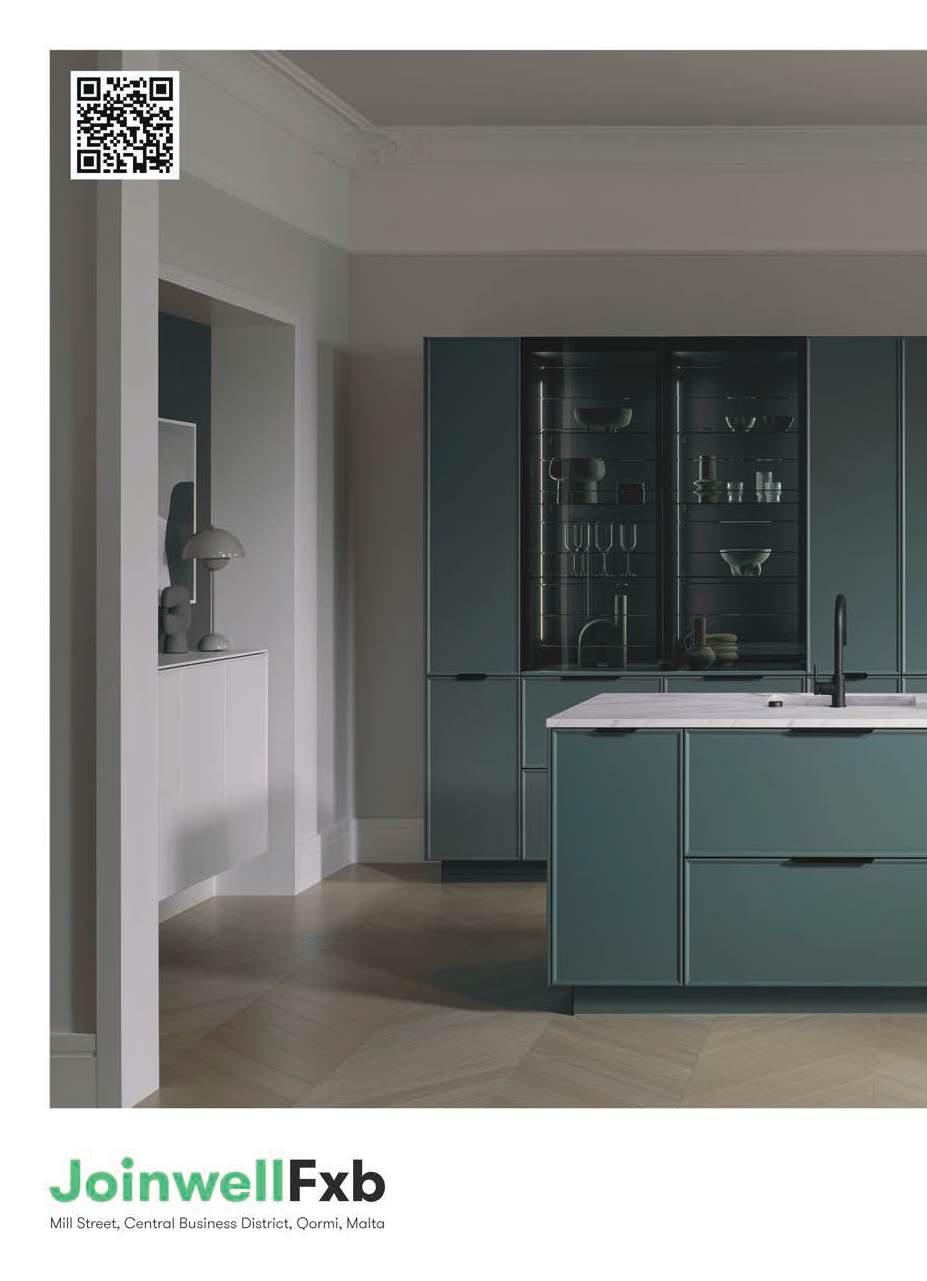
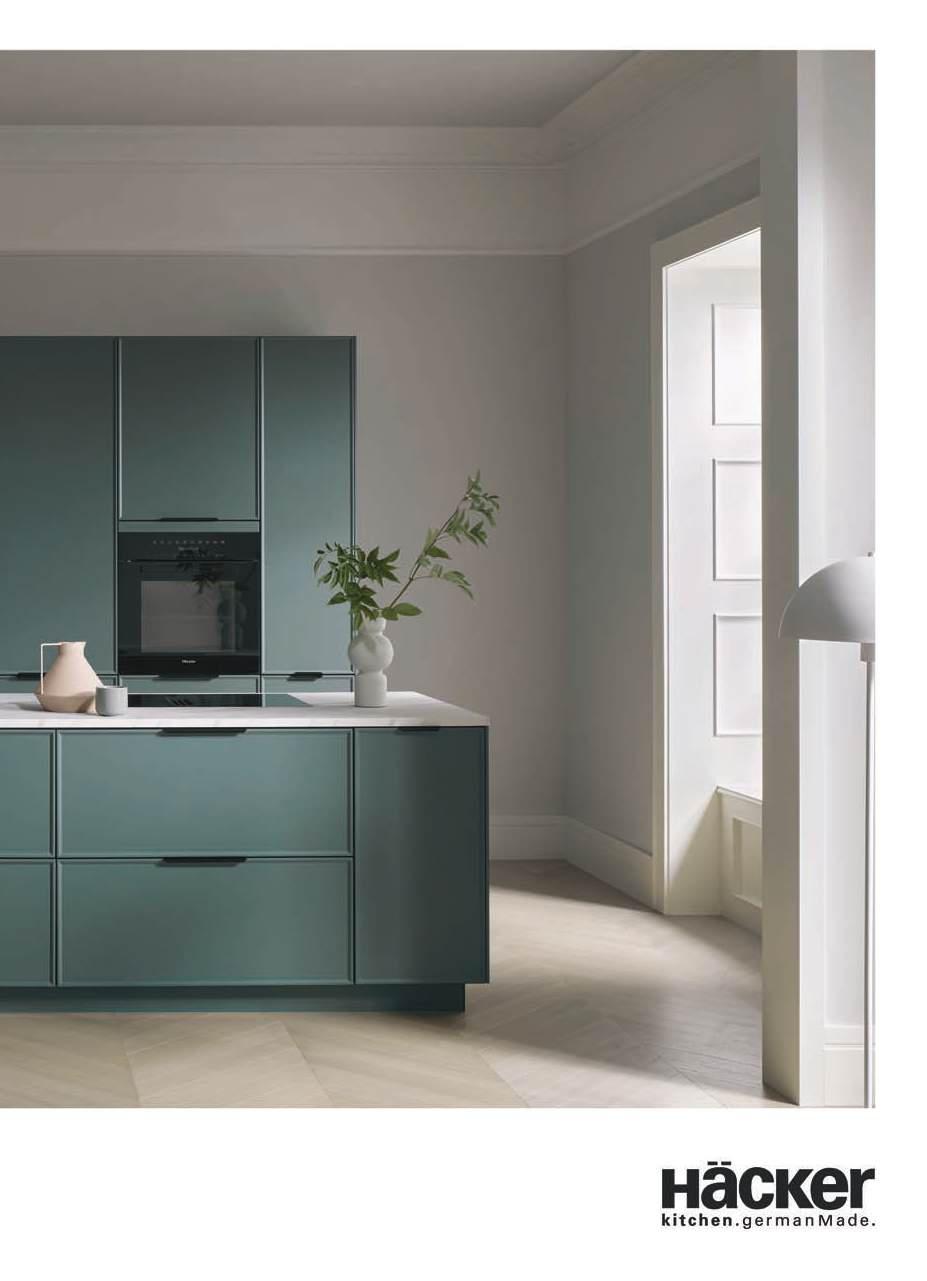

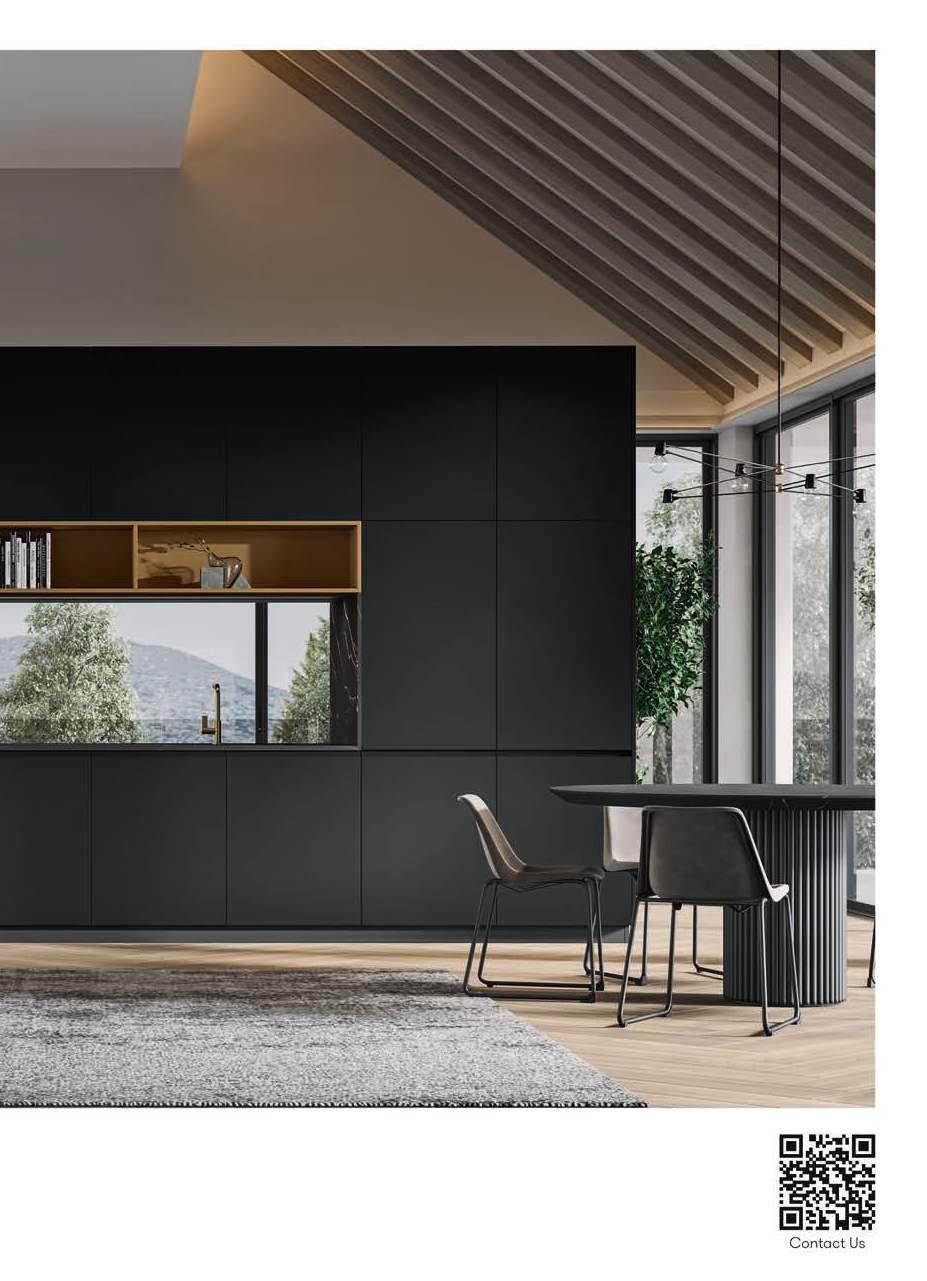

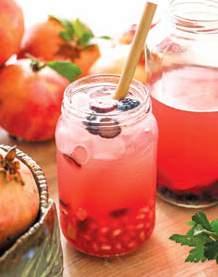



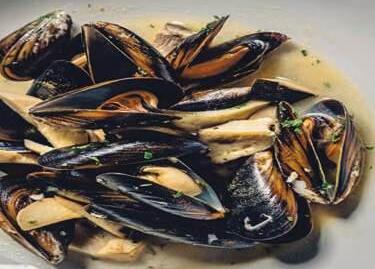
Michael Diacono’s hearty seafood for cooler weather 30 A snack for all seasons
Indulge in our fig and gorgonzola tart 32
Uncorking surprises
Andrew Azzopardi on the art of unexpected wine pairing 34
Symphony of soup
Wrap up in the comfort of heart-warming food 44
Jewel of autumn
Claire Borg’s pomegranate recipes
Reimagined tradition
The transformation of a Sliema townhouse
Casa Ursula
Award-winning architecture 78
A room with a view
Lydia Cecil’s new exhibition

CHRISTMAS STAFF PARTIES
AT PALAZZO PARISIO




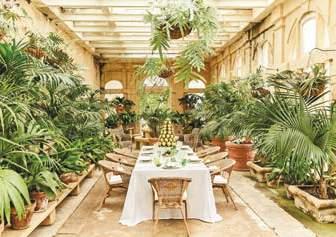

Tepid wine, shrimp boats, a scraggly Father Christmas with a hint of booze on his breath. Such is the stuff of office party nightmares. Throw in Jesmond from accounts with his roving eye and wandering hands and no wonder the drinks go down fast.
But then again, there are staff parties and there are staff parties. After a year of Gantt charts, difficult clients and balancing chequebooks, your team deserves a little bit more than the sad celebration mentioned above. Now more than ever, with work flexibility meaning that the social aspect is often missing thanks to many working from home, a meaningful gathering with those who make work work, is essential.
When working in a palace, one becomes used to the pressure of perfection. As one steps into the great hall, it’s hard to imagine that anything else is on offer. So too with creating bespoke events for our clients. Palazzo Parisio is a 19th century Belle-Epoque masterpiece and we are lucky to have had this beautiful setting created for us. Our responsibility lies with ensuring that this flawless and unique experience carries on through to that final espresso that washes it all down.
In 2007, the late Baroness Christiane Ramsay Scicluna took over the running of the palace as a team with her daughter, the then Baronessina Justine Pergola, they came in with a minimum standard and that was where everything had to rise to. This translated firmly into the service and catering aspects of the business. Whereas previous events used to rely on outside catering, all was brought in-house to ensure excellence across the board.
When dealing with nobility, one is used to all manner of requests. And for our events team, these daily challenges are the fire that fuels us. Brunch in the orangery? Banquet in the ballroom? Tea on the terrace? We’ll make it happen.




As the Christmas season approaches, explore a selection of gift ideas that will delight - from culinary is as always bursting with world-renowned specialities for that special treat or gift. For the past 20 years, our selection of fine foods is second to none with innovative items being presented each year. Our large cellar houses more than 300 labels of wine and an extensive selection of Whiskies and other spirits. Pack your personalised gifts in luxury wicker baskets or the signature Dical House gift boxes. Dical House is open all day every day during the festive season and is in Triq San Anton Abbati, Mosta. On certain days such as Christmas day and eve Dical House opens with reduced hours. Tel.: 21424600/1. Full customisation and delivery of hampers is also possible. Email: foods@dicalgroup.com or web: www.dicalhouse.com


If you are looking for the one place on the island where you can find all your festive must-haves, head straight to DICAL HOUSE and feast your eyes on an extensive selection of gifts and hampers. All hampers can ALSO be customised according to your taste and budget to ensure yours is totally filled with individually handpicked items. Dical House brings you the finest food products from around the world. With hundreds of gourmet items to choose from, your difficulty will be what to leave out rather than what to choose. Corporate clients can request a private meeting via email on foods@dicalgroup.com. Whatever the case, don’t forget to buy a gift for yourself. Dical House is in Triq San Anton Abbati. It is easy to find also on Google maps. Tel.: 21424600/1. Email: foods@dicalgroup.com or web: www.dicalhouse.com
Dical House specialises in offering the best from around the world and as vast a selection as possible. The products are individually selected and hail from the UK, Italy, France, Greece, Belgium, Spain and other countries to ensure the very best items are brought in. The choice of items to fit budgets becomes easy as there is a wide selection of each high quality product type. In most cases, we offer around twenty different choices of each product type: olive oils, balsamic vinegars, pasta and pasta sauces, cheeses, salamis, chutneys, chirstmas cakes, pudding, panettone, and so many other artisan items. Visit www.dicalhouse.com to gain insight into a few of the festive items available. For the real deal, a visit to the store is a must. Tel.: 2142 4600/1.


If you’re on the hunt for bespoke personalised gifts and hampers filled with extraordinary premium quality and artisan products that truly stand out, then the Dical House flagship Store in Triq San Anton Abbati, Mosta is the place to visit. Suggested hampers can be seen on www.dicalhouse.com but each one can be customised according to your taste and budget. Dical House hampers can also be delivered anywhere in Malta and Gozo. Just be sure to think ahead to avoid disappointment as certain items will be gone well before Christmas. Contact details – tel.: 21424600/1, email: foods@dicalgroup.com

treasures to elegant home accents, discover presents that bring warmth and flair to the festive season.



Côte Noire - The Gift Box. Price: €85. The Gift Box is an exclusive gift set that contains a rose in a glass vase, two room scents, a scented candle and a diffuser with scented sticks and perfume. Spraying the fragrance on to the petals of this exquisite faux rose gives you a lovely overall sensory experience. The scented candle is made of 100% natural beeswax, soy and coconut. The scented sticks are highly absorbent reeds that exude their scent for up to two months. Exclusively available at Grey & Adler of Labour Avenue, Naxxar – Call 99823319 or shop online www.greyandadler.com/cotenoire
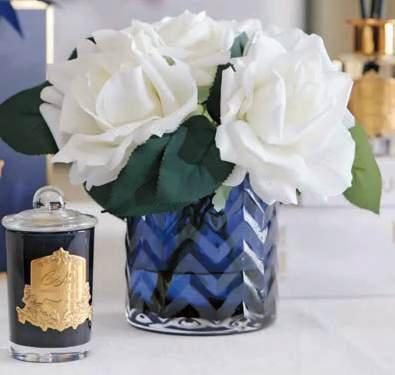
Côte Noire - The Herringbone. Price: €85. The Herringbone is an exclusive decorative bouquet of faux flowers and accompanying perfume sprays. The bouquet consists of exquisite white faux roses in a blue glass vase with a fishbone pattern. Spraying the fragrance on to the flower petals gives you a lovely overall sensory experience. The lifelike roses are supported in a gel, which holds the bouquet stable in the vase. The flower petals are handmade and they have a thin coating, making them both look and feel like real roses. Exclusively available at Grey & Adler of Labour Avenue, Naxxar – Call 99823319 or shop online www.greyandadler.com/cotenoire

Côte Noire - The Grand Bouquet. Price: €180. The Grand Bouquet by Côte Noire is an exclusive decorative bouquet of faux roses. The exquisite bouquet consists of high-quality faux white roses in a glass vase with a majestic gold emblem. Spraying the fragrance, which you will find in the gift box, on the flower petals gives you a lovely overall sensory experience. The lifelike roses are supported in a gel, which holds the bouquet stable in the vase. The flower petals are handmade and have a thin coating, making them both look and feel like real roses. Exclusively available at Grey & Adler of Labour Avenue, Naxxar – Call 99823319 or shop online www.greyandadler.com/cotenoire


Côte Noire - The Crytstal Bowl Collection. Price: €130. This is an exquisite bouquet of faux roses in a pretty round glass vase. Spraying the fragrance on to the flower petals gives you a lovely overall sensory experience. The lifelike roses are supported in a gel, which holds the bouquet stable in the vase. The flower petals are handmade and they have a thin coating, making them both look and feel like real flowers. All Côte Noire flowers are delivered in exquisite gift boxes that will delight your friends and family who receive them. Exclusively available at Grey & Adler of Labour Avenue, Naxxar - 99823319 or shop online www.greyandadler.com/cotenoire
Seafood in November offers a fresh and flavourful twist on cooler-weather cooking, proving that the Mediterranean’s bounty can be enjoyed all year round.
Food Michael Diacono, chef patron, Giuseppi’s Bar and Bistro
Photography: Brian Grech
Wine recommendation: Andrew Azzopardi, Vintage 82

“As the days grow shorter and the air starts to turn crisp, we fill our tables with the comforting flavours of autumn. While seafood often calls to mind hot summer days, the bounty of the sea can be equally satisfying in the cooler months. Autumn is an ideal time to explore heartier dishes that offer warmth and depth, and capture the essence of the sea.”

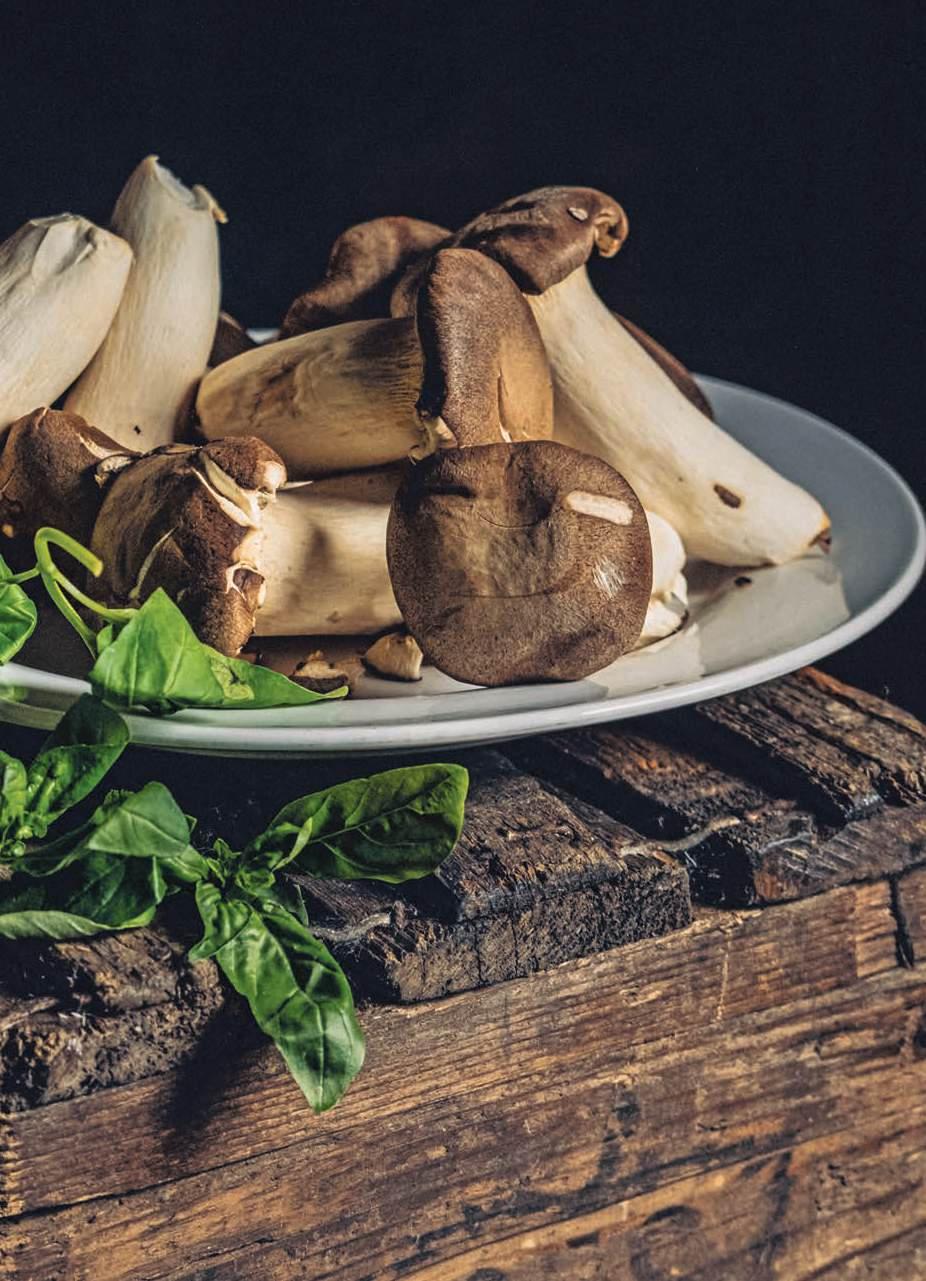

The underlying flavour of Pastis in this soup gives a very satisfying warmth to this decadent starter.
SERVES 6
PREPARATION AND COOKING 45 minutes
RECOMMENDED WINE “This being an extremely delicate dish, I would choose a wine that is fresh, without any overpowering flavours. A good quality Sancerre, a Riesling or an unoaked Vermentino would be fantastic choices.”
YOU WILL NEED:
2 tablespoons plain flour
50g unsalted butter
1 large fennel bulb, cleaned and chopped
2 tomatoes, cubed
1 tablespoon tomato paste
70ml Pastis or Sambuca
600g small prawns, shelled weight
2 l prawn stock
salt and pepper
a small amount of fresh dill
12 shelled fresh scallops
a few pinches sugar
1. First, make the prawn stock by boiling the shells in approximately 2.5 litres of water with a pinch of salt for about 20 minutes then strain the liquid to remove the solids. You will need 2 litres of stock.
2. Next, heat a large deep pot and add the flour. Toast it for a couple of minutes then transfer it to a bowl.
3. Melt the butter in the same pot. Add the chopped onion and tomatoes and stir fry gently for a few minutes to soften the vegetables. Add the tomato paste and cook this out for a couple of minutes.
4. Add the Pastis and set it alight. When the flame dies down, add the prawns and mix them well.
5. Add the toasted flour and hot stock. Bring the mixture to the boil, then let the pot simmer for 20 minutes. Add a little chopped dill and use a stick blender to purée the soup. Season to taste.
6. Pat the scallops dry using kitchen towel and set a skillet on the cooker to heat up. Sprinkle the scallops with a very little sugar. Wipe the warmed skillet with extra-virgin olive oil, then place the scallops, sugared side down, on the hot surface and sear them for just a few seconds. Serve the scallops in the soup.



YOU WILL NEED:
500g plain flour, sifted
350g apple purée
15g instant yeast
5ml extra-virgin olive oil
2 tablespoons sunflower seeds
1 teaspoon salt
1. Mix all the ingredients together to form a dough then shape it into a square loaf. Place this on a baking sheet lined with baking parchment.
2. Set the dough aside in a warm place to rise for 40 minutes.
3. Heat the oven to 180°C. Bake the loaf for 25 minutes, then let it cool for 30 minutes. Slice it lengthways and place the slices on the baking tray.
4. Cook the bread for a further 17 minutes till it browns and crisps up.

This recipe is simplicity itself, made with a few choice ingredients cooked swiftly on high heat that give maximum pleasure. A word of advice - do not prepare mussels at home for crowds. I find that a domestic cooker is not powerful enough to cook mussels swiftly in a large pot.
Taste&Flair note: Choose mushrooms that appear plump and which have a fresh, smooth appearance. Store them in a porous paper bag, not in plastic.
SERVES 2
PREPARATION AND COOKING 30 minutes (including time to scrub the mussels clean) RECOMMENDED WINE “My go-to wine would be a good quality, mature Chablis or Bordeaux Blanc. The high acidity would perfectly cut through the fattiness of the mussels and the umami from the age (maturity) will be delicious with the mushrooms.”
YOU WILL NEED:
1kg fresh mussels extra-virgin olive oil
2 large King Oyster mushrooms, wiped clean 2 cloves garlic, peeled and chopped 200ml dry white wine a handful parsley, chopped a few fresh basil leaves
1. Scrub the mussels clean under running water.
2. Heat a good glug of extra-virgin olive oil in a large frying pan. Slice the mushrooms and add them to the pan. Stir fry for a minute, then add the garlic. Cook for a few seconds.
3. Add the mussels. Toss the mussels in the pan, then douse the mixture with the white wine. Cover the pan and let it steam for a few minutes till the mussels open. Add the herbs and serve at once.
‘Mosciame’ (CURED AND DRIED TUNA BELLY)

There is always something so satisfying, at least to me, in the slow process of curing foods at home. It might be my calm nature.
SERVES 8
PREPARATION AND CURING TIME 16 days
RECOMMENDED WINE “Cured fish calls for unoaked, high acid wines to keep the palate refreshed and wanting more. There are several good options such as a fresh Sauvignon Blanc, Riesling or even a good quality Grüner Veltliner.”
YOU WILL NEED:
1 kg fresh tuna belly in one piece
200g sea salt
200g brown sugar
TO SERVE: sharp-tasting apple mustard
1. Mix the salt and sugar together. Place the tuna belly into a glass dish and sprinkle it with the salt and sugar mix, making sure the tuna is completely covered.
2. Place a clean, stainless steel tray on top of the tuna, and weigh it down. Place the dish in the fridge.
3. Every day, turn the fish once. After 9 days, rinse the fish well and pat it dry.
4. Now, tie the fish securely with kitchen twine and hang it in the fridge to dry for at least a week.
5. To serve, simply slice this very thinly using a very sharp knife. I find a sharp apple mustard goes very well with this.



At the beginning of summer, I gave the recipe for rabbit spring rolls, and now, with the lampuki season in full swing, I thought why not? I took my lampuki pie filling and used that to fill the spring rolls. Make loads of these and freeze them. You can cook them straight out of the freezer. I served them with a tomato and caper dipping sauce.
MAKES 40 rolls
PREPARATION AND COOKING 60 minutes
RECOMMENDED WINE “Due to the richness of lampuki, we can opt for a slightly richer style of wine with good structure such as a Viognier or even a Pinot Gris. I would still be a little careful and avoid oak as much as possible.”
YOU WILL NEED:
3 tablespoons extra-virgin olive oil
1 larege red onion, peeled and finely chopped
2 garlic cloves, chopped
2 tomatoes, chopped
1 tablespoon tomato paste chili
400g cooked spinach, drained
1 teaspoon mixed spice salt and pepper
12 black olives, stoned and roughly chopped
1 tablespoon capers
1 tablespoon sultanas finely chopped parsley
1 tablespoon finely chopped fresh mint
70g shelled walnuts
600 g filleted lampuki, cut into small chunks
40 spring roll wrappers oil to fry
1. Heat extra-virgin olive oil in a large pot. Stir fry the onion and garlic together for a few minutes to soften them. Add the chopped tomatoes and paste and cook for a further couple of minutes before adding chilli.
2. Mix in the spinach then season with mixed spice, salt and pepper. Cook for 5 minutes then turn off the heat.
3. Let the mixture cool, then add the chopped olives, capers and sultanas and mix in the herbs and walnuts. Finally, stir in the raw lampuki pieces.
4. Spoon the filling onto the spring roll wrappers and roll them up using water to seal the edges. Bag and freeze them, unless you serving them right away.
5. For best results, deep fry the spring rolls in plenty of vegetable oil till they turn golden and crisp. You may also bake thnem in a preheated oven set to 190°C. Brush the rolls with oil before baking and cook them for about 10 minutes, turning them over twice during cooking.


During a trip to Rome a few years back with my younger siblings, we had lunch at a beautiful little restaurant in an extremely picturesque small piazza, where the fish was baked in thinly sliced potatoes. I cannot remember much of that lunch after the main course, but my inspiration for this recipe came from there.
SERVES 4
PREPARATION AND COOKING 30 minutes
RECOMMENDED WINE “Keep the wine delicate, light and fresh. Dry Rieslings and Sauvignon Blancs are the first to come to mind. Due to the pine nuts and Zucchini, I believe a bottle of unoaked Torrontes or Fiano D’Avellino could also work beautifully.”
YOU WILL NEED:
4 filleted fresh sea bass, approx 500g each before cleaning, skin removed too salt and pepper
2 tablespoons lightly toasted pine nuts
1 tablespoon chopped fresh mint juice of 1 lemon extra-virgin olive oil
3 zucchini, thinly sliced on a mandolin
1. Prepare a baking tray large enough to hold the 4 fish by lining it with baking paper.
2. Place one fillet of each fish on the tray, skin side down . Season with salt and pepper.
3. Scatter the pine nuts over then sprinkle with the chopped mint. Drizzle with the lemon juice and a little extra-virgin olive oil, then cover each fish with the other fillet.
4. Brush the fish lightly with extra-virgin olive oil, then cover the fish with the thinly cut zucchini, overlapping the slices to emulate fish scales.Brush the zucchini lightly with extra-virgin olive oil.
5. Bake the prepared fish in a preheated oven set to 190°C for 14 -15 minutes, then serve at once.

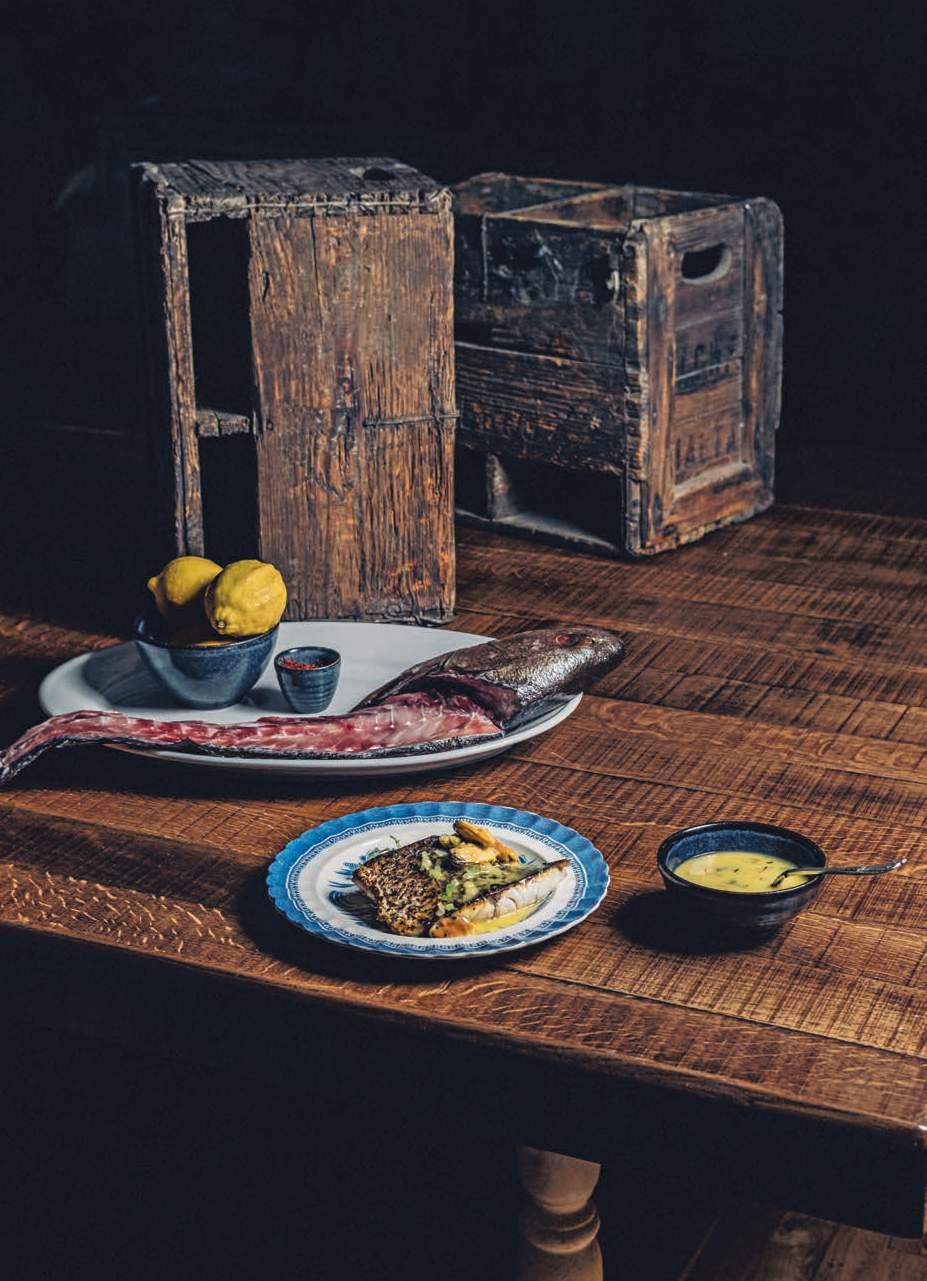
I must admit to maybe preferring to eat fish simply grilled with a squeeze of lemon juice and some sea salt flakes to dip into. However, once in a while, a good sauce, on the side, does no harm, especially if cooking for guests.
SERVES 4
PREPARATION AND COOKING 40 minutes
RECOMMENDED WINE “Due to the creaminess of the dish, I would opt for a wine with body and structure, without overpowering the delicate flavours of the dish. Wines with a little bit of oak would work well. Bordeaux Blanc, Premier cru Chablis, Etna Bianco and elegant (slightly oaked) Burgundy white would work beautifully with the dish. Champagne would also work like a charm.”
YOU WILL NEED:
250ml fish stock
1 coffee spoon saffron strands
30ml extra-virgin olive oil
30g butter
1 medium onion, peeled and chopped finely
1 small tomato, diced
2 cloves garlic, peeled and chopped chili pepper
500g fresh mussels, cleaned
250ml dry white wine
125ml coconut milk juice of ½ lemon
a little chopped parsley
4 fillets Gurbel, approximately 225g each
1. Heat the fish stock till warm, then steep the saffron strands in it. Set this aside.
2. Heat the extra-virgin olive oil and butter together in a pot till the butter melts ,then add the onion and tomato. Cook these together till they soften, then add the garlic, the chili (if using) and pepper.
3. Add the white wine and saffron infused stock. Reduce the liquid to 1/3 then add the mussels and coconut milk. Cover the pan and steam the mixture for a few minutes till the mussels open. Remove them from the sauce.
4. Take the meat out from the shell and return it to the sauce. Add the lemon juice and chopped parsley.
5. Season the fish with salt and pepper and brush them with extra-virgin olive oil. Grill the fish, skin side down, for 4 minutes before flipping them over. Cook for a further 2 minutes, then serve immediately with the hot sauce.

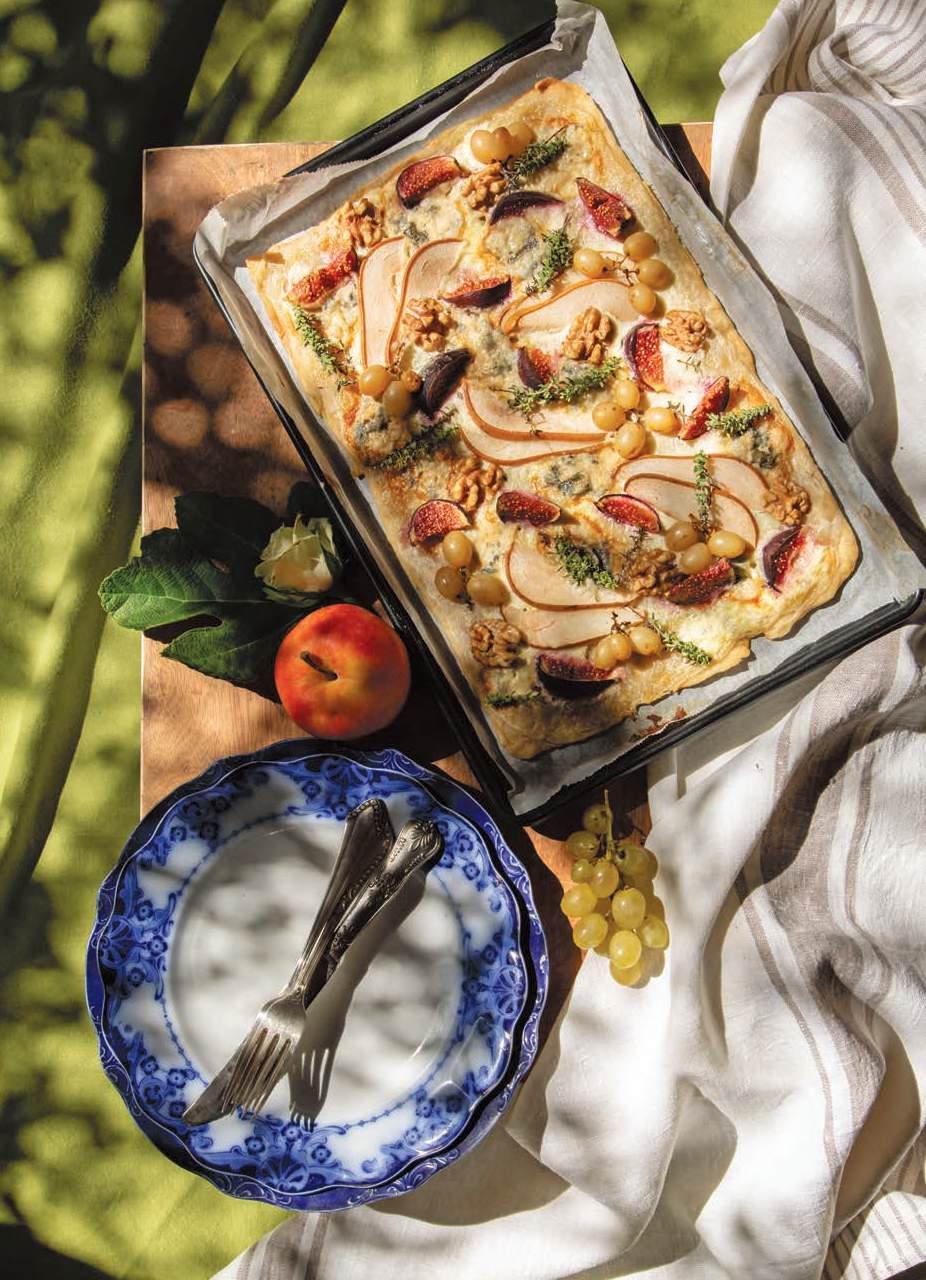
For a savoury snack that’s simple but flavourful, this fig, walnut, grape, and gorgonzola tart drizzled with honey is a delicious choice. The sweet figs and juicy grapes balance perfectly with the tangy, creamy gorgonzola, while the crunchy walnuts add a satisfying crunch. A touch of honey brings everything together, creating a perfect balance of sweet and savoury. It’s great for casual gatherings or as a light bite that pairs well with a glass of wine, and accompanied by a fresh rocket salad, simply dressed with extra-virgin olive oil.
Photography: Corinne Vella
Serves 2-4
FOR THE PASTRY:
110ml cold water
28ml olive oil
½ teaspoon finely ground salt
240g plain flour
FOR THE TOPPING:
200ml sour cream
1 handful walnut halves
2-3 black figs
Maltese wild thyme honey
1 small bunch sweet
white Maltese grapes
60g gorgonzola picante
2 pears
several sprigs of fresh thyme fine salt
1. First, make the pastry. Sift the flour into a bowl, make a well in the centre and pour in the water and oil. Sprinkle in the salt and use a blunt knife or a spatula to fold the mixture together until it forms a dough. Knead the dough lightly then shape it into a flat disc, wrap it in cling film, and chill it for at least 30 minutes or overnight.
2. Line a baking tray with nonstick paper and preheat the oven to 175°C. Wash the fruit and thyme thoroughly and pat them dry. Trim the grapes into small bunches of 2-3 grapes.
3. Roll out the pasty and transfer it to the baking tray. It should be around 4mm thick. Lightly whip the chilled sour cream and use a spatula to spread it out evenly all the way to the edges of the pastry. Sprinkle the salt over the cream layer.
4. Trim, halve, and core the pears and slice them thinly, and quarter the figs. Place the pear slices, fig quarters, and grape bunches on the cream layer. Using your hands, roughly break up the gorgonzola and scatter it over the fruit. Dot the whole walnut halves and thyme sprigs in the remaining space.
5. Bake the tart in the preheated oven for 15 minutes or until the gorgonzola melts and the pastry starts to turn golden. Serve this warm, sprinkled with fresh thyme sprigs.
Gorgonzola cheese is one of Italy’s oldest blue-veined cheeses. Its name comes from the town of Gorgonzola, located near Milan in the Lombardy region, where it was first produced over a thousand years ago, around the 9th to 11th centuries. Traditionally, Gorgonzola was made in the autumn when cows would descend from the Alps after grazing on mountain pastures when their milk was at its richest.
Today, Gorgonzola is still produced mainly in the regions of Lombardy and Piedmont, where it has been granted Protected Designation of Origin (DOP) status by the European Union, ensuring that authentic Gorgonzola can only be produced in certain provinces using specific production methods.
Gorgonzola’s distinctive blue veins come from the Penicillium mold introduced during the aging process, which gives the cheese its characteristic tangy flavor and creamy texture. Soft and creamy Gorgonzola dolce is left to age for 50-150 days. Gorgonzola piccante is firmer and crumblier and is aged for 80-270 days.


Wine doesn’t have to be a serious affair. It should be an exploration of flavour, joy, and excitement, says Andrew Azzopardi
Wine is often taken way too seriously – tannins, carbonic maceration, and all that technical jargon –but let’s not forget that it’s fundamentally about enjoyment. Wine should be fun, a playful accompaniment to our meals rather than a stuffy connoisseur’s exercise. Yes, it’s fascinating to understand the intricacies of a vintage Bordeaux or the nuances of a Premier Cru Burgundy, but let’s get real: the most memorable wine moments often come from unexpected pairings that you’ll remember, despite the raised eyebrow.
It’s easy to play the safe game, matching an expensive Bordeaux with equally pricey wagyu beef or indulging in luxury Champagne alongside Sturgeon caviar. These pairings are practically on the menu of every posh restaurant and wine pairing as of late, to the point that it’s even verging on being boring. But how often do we reach for familiar comfort food such as takeout, only to discover that it can lead to a remarkable gastronomic revelation?
Take my recent culinary experience, for instance. Last Wednesday night, while my wife was out channeling her inner Serena Williams, I whipped up a couple of omelettes for the kids and myself, throwing in a few button mushrooms and a sprinkle of parsley and chopped chives for bit of flair. I pulled the cork on an already opened bottle of 2017 Puligny-Montrachet, which was used for a tasting the day before. I never thought such a casual dish could be elevated to such luxurious heights. The buttery richness of the fluffy eggs on toast paired beautifully with the equally delicious Chardonnay. We should never hesitate to pop open a fine bottle just because we’re not serving Kobe beef or freshly caught lobster. Sometimes, the humble omelette, takeaway pizza, or a cheeky cheese and egg burger might be the unexpected pairing you’ve been craving.
So, without further ado, here are a few of my favourite unexpected pairings that will delight your palate and perhaps even make you chuckle.

Yes, you read that right. Picture this: you’re devouring a box of fried chicken takeout – greasy fingers, crackling skin – while pouring yourself a glass of your favourite Champagne. It sounds downright ludicrous, but trust me, it’s a match made in culinary heaven. The effervescent bubbles cut through the greasy richness like a hot knife through butter. The wine’s acidity brightens every bite, while the salty, crispy chicken is softened by the Champagne’s effervescence and complex, yeasty undertones. It’s a guilty pleasure. The minerality and crispness of a good bottle (ideally with a touch of age) balances effortlessly with the salt and fat of the chicken. It’s as if they were meant for each other, one from from the sun-kissed vineyards of France and the other emerging from a local deep fryer and delivered by courier. The flavours are pairing perfection.
Sauternes and Oysters
If you thought Champagne and fried chicken was a wild pairing, wait until you introduce your guests to a bottle of luscious Sauternes with those Fine de Claire oysters you just bought. While most people instinctively reach for a mineral white, like Chablis, Sauternes offers an entirely different experience. The honeyed sweetness of this iconic Bordeaux dessert wine, with its aromas of apricots, citrus, and a hint of noble rot (botrytis), is the perfect counterbalance to the briny nature of oysters. When I first

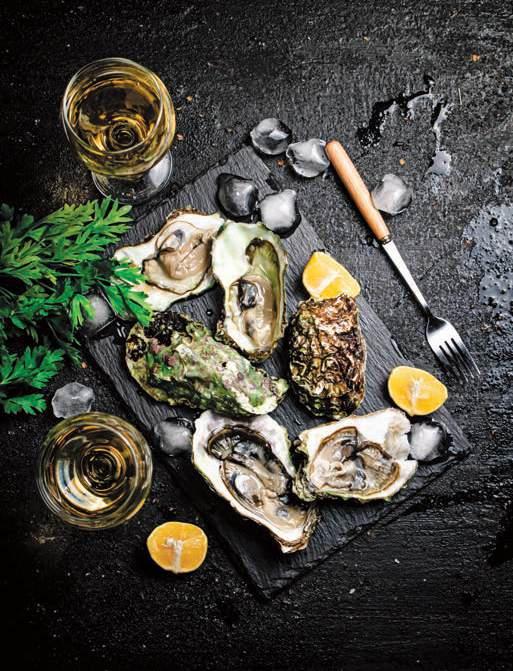
tried this pairing, I was admittedly taken aback. Could something so sweet really complement the sharp, oceanic tang of a fresh oyster? But as the Sauternes envelopes your palate, it enhances the oyster’s salinity and depth. The wine’s high acidity cuts through richness, leaving you wondering why this pairing isn’t as legendary as Sauternes with foie gras. It’s decadent, sophisticated, and just a tad rebellious.
Oaked Chardonnay and Buttered Popcorn

WE SHOULD

We’ve all fantasized about a cozy evening at home, snuggled up with friends or loved ones, a film flickering on the screen, and a glass of wine in hand. As the buttered popcorn pops and the movie begins, the choice of wine becomes obvious: Oaked Chardonnay, of course. The popcorn brings out the nutty flavours of the Chardonnay, while its buttery notes perfectly complement the popcorn’s richness. Next time my wife, Roberta, insists on watching another episode of “Emily in Paris” I’ll pour myself a bottle of Californian Chardonnay aged in oak, and pop some buttered popcorn to keep me entertained. That doesn’t sound bad at all, in spite my wife’s love of chick flicks.
Bacon Cheeseburger and Pinot Noir
Ah, the Pinot Noir— that grape that inspires endless discussions about terroir, and “forest floor” aromas, as if wine snobs have crawled their way through the Morvan forest in Burgundy after a rain shower. But let’s get real: what
pairs perfectly with this so-called delicate and luxurious varietal? A homemade cheese and bacon burger, that’s what. The kind you devour with one hand, wiping grease off your chin with the other. The earthy, complex notes of Pinot Noir—layered with aromas of red fruits and subtle spices— work beautifully with the smoky char of a freshly grilled, home-made burger. Its silky tannins cut through the richness of the beef and melted cheese, creating a beautifully rebellious experience. Forget the white tablecloths and pretentious sommeliers; this is a pairing perfection that feels satisfyingly naughty.
While most would naturally gravitate towards a crisp white or an elegant red to accompany a roast pork dinner, consider being daring with Oloroso sherry. Its rich, nutty style, with notes of leather and raisins, is a surprisingly perfect match for your Sunday roast, especially if there’s a large dollop of apple sauce on the side. If you’re not up to drinking sherry throughout the whole meal, serve your guests a glass of vintage Oloroso sherry with the crackling as an appetizer before the main event. The rich, savoury flavour of the crackling contrasts beautifully with the sweet, nutty notes of the sherry. This delightful interplay of flavours is both satisfying and somewhat dangerous, as the higher alcohol content (around 17-20%) helps cleanse the palate and invites you to reach for another piece of crackling...and another glass of wine.
Wine doesn’t have to be a serious affair; it’s not just for snooty wine snobs and experts. It should be an exploration of flavour, joy, and excitement – or even a bit of mischief. Whether you’re indulging in fried chicken and Champagne or taking that leap of faith with Sauternes and oysters, these unexpected pairings invite you to step outside your comfort zone. So, go ahead, pop open that special bottle, and relish the delightful surprise of your next meal. You just might discover your new favourite pairing along the way.
Andrew Azzopardi is a wine specialist certified by the Wines and Spirit Education Trust.

Longer evenings and cooler weather are the perfect reason to slow down and wrap yourself in the comfort of heart-warming food.
Photography: Corinne Vella
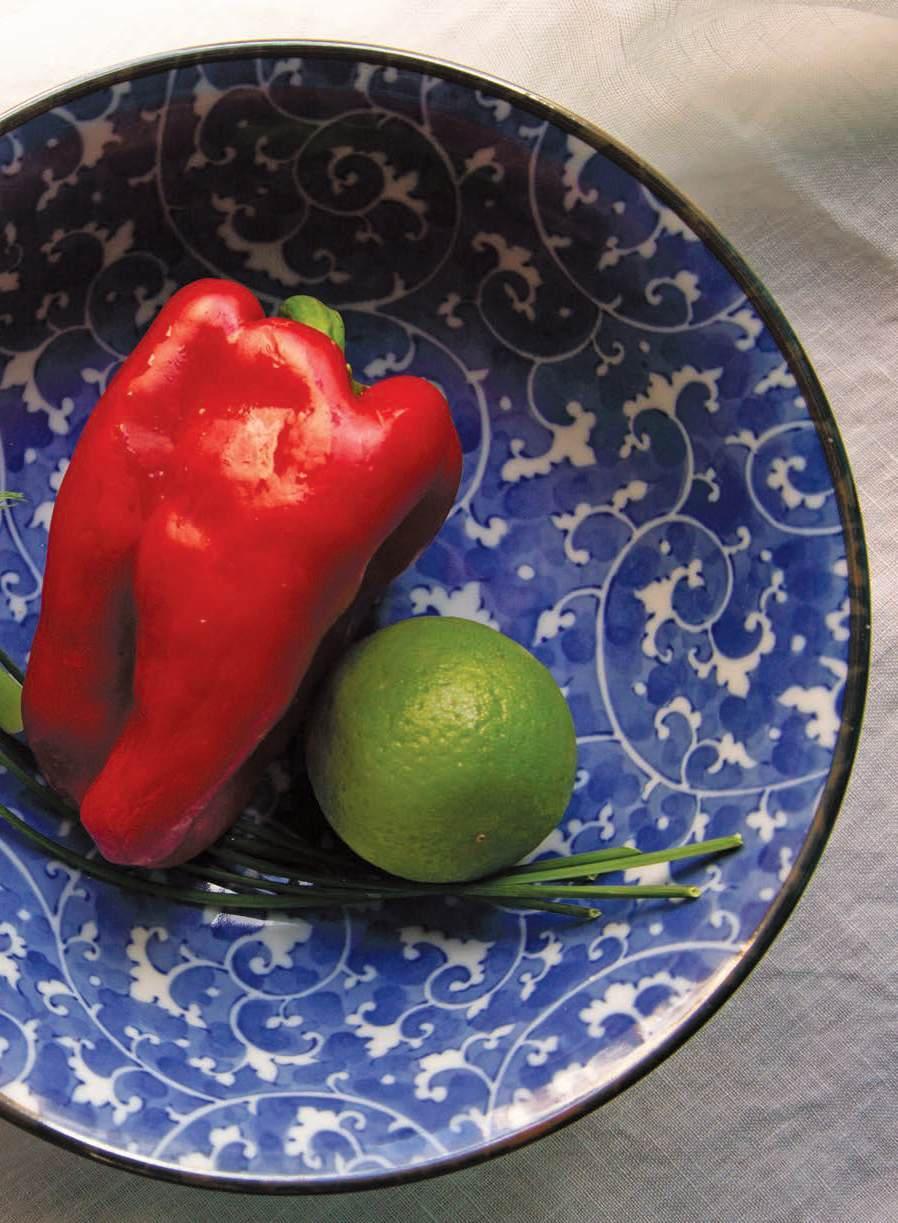
This is one for beetroot fans. The licoricelike tarragon adds a fresh note to the earthy beetroot and oniony chives.
Serves 3-4
YOU WILL NEED:
300g beetroots, peeled, pre-cooked, and diced
1 garlic clove, peeled and finely chopped
1 small onion, peeled and diced
1 tablespoonful chopped fresh tarragon
1 tablespoon snipped chives
salt and pepper
3 tablespoons apple cider vinegar
1 tablespoon olive oil
8 tablespoons lactose-free plain yogurt
900ml vegetable broth (gluten-free)
1 pinch ground cayenne
TO GARNISH: snipped chives
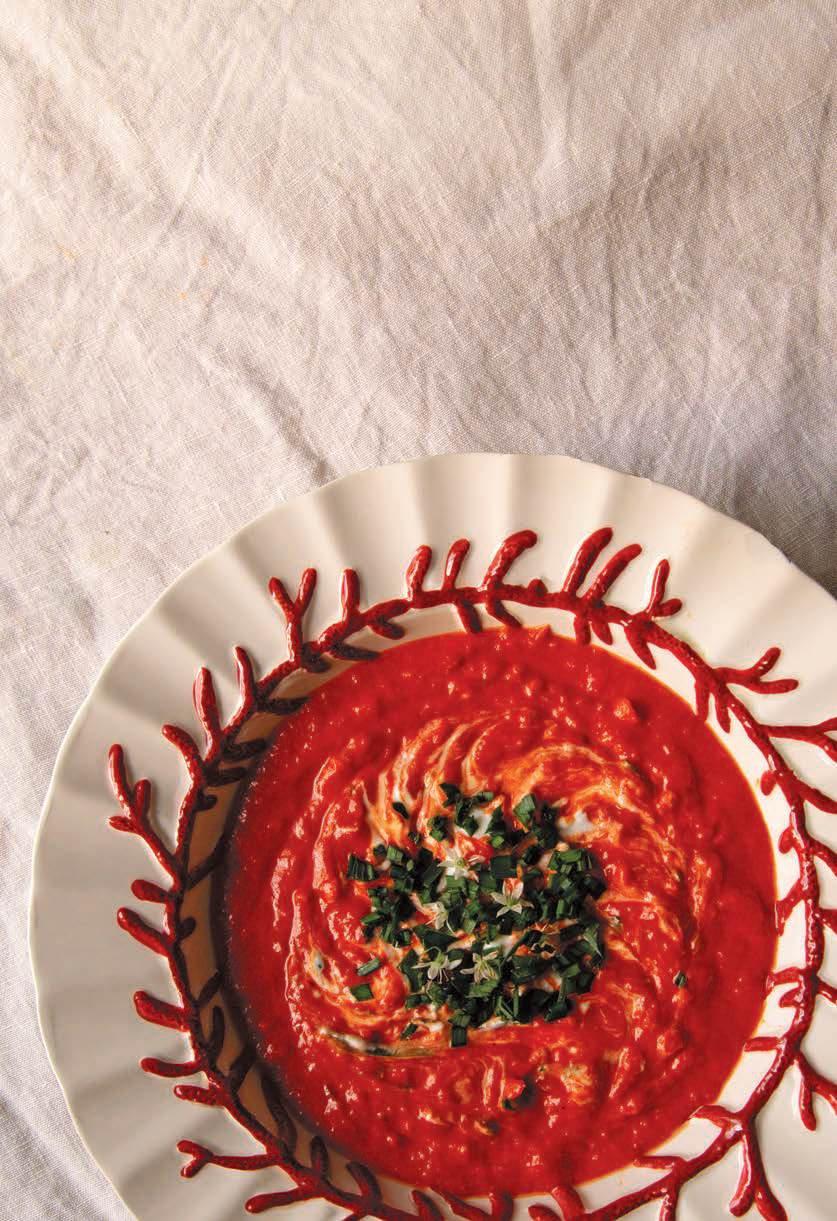
1. Warm the olive oil in a pot and cook the onion and garlic until they soften. Add the chopped beetroots and seasoning. Stir in the vinegar and cook the mixture for a few minutes over a gentle heat.
2. Add the broth and let the pot simmer until the beetroots are softened completely (around 10 minutes).
3. Blend the soup until smooth. It should be fairly thick but you can add more broth to thin it out, if you prefer.
4. Stir in the tarragon and a tablespoonful of chives and ladle the soup into individual soup plates. Add a dollop of yogurt to each plate and swirl it in. Serve topped with snipped chives.


This is really one for long cold evenings, when spending time in a warm kitchen is comforting. It’s mildly sweet with spicey chilli notes. If you like your soup hot in more ways than one, add more chillis.
Serves 4
Preparation and cooking: 2.5 hours
YOU WILL NEED:
3 dark red capsicum peppers
750g tomatoes
1 red onion peeled and chopped
1 large red chilli pepper
2 garlic cloves
300ml vegetable stock
4 slices sourdough baguette
60g crumbly goat’s cheese
1 tablespoon soft brown sugar
1. Preheat the oven to 180°C. Deseed and chop the peppers. Peel and chop the onion and garlic. Put the vegetables in a roasting tin, drizzle with the olive oil and sprinkle with the sugar (this will help the vegetables caramelise). Toss the mixture until the vegetables are well coated in oil. Roast the vegetables in the preheated oven for two hours, stirring occasionally to avoid charring.
2. Now, transfer the roasted vegetables to a soup pot, pour in the stock and use a stick blender to process the mixture until it is smooth. Warm the soup gently over a low heat for five minutes.
3. Toast the sourdough slices and top them with crumbled goat’s cheese. Ladle the soup into serving bowls and top with the cheese toast. Serve immediately.
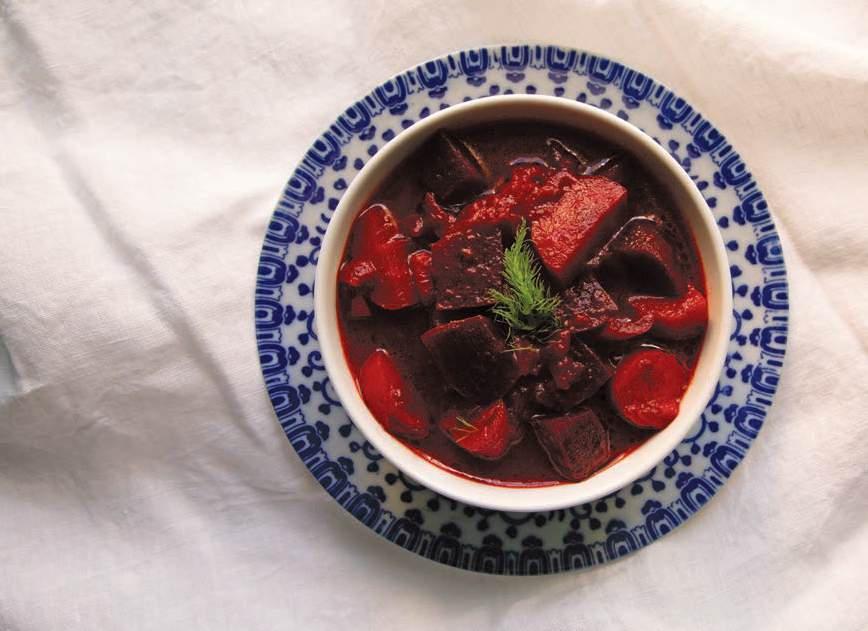
Lightly spicey and saturated with flavour, this can be made ahead and kept refridgerated for 2-3 days.
Serves 2
Preparation and cooking: 80 minutes
YOU WILL NEED:
2 large beetroots, peeled and diced
2 medium carrots, scraped and diced
1 medium red onion, diced
4 fresh tomatoes (or 1 can whole peeled tomatoes)
2 garlic cloves, finely chopped
1 ½ tablespoons extra-virgin olive oil
1 teaspoon ground cumin and chili pepper • salt flakes
TO GARNISH: fresh dill tips • plain Greek lactose-free yogurt (optional)
1. If you’re using fresh tomatoes, dunk them in hot water and peel them, then remove the seeds. If you’re using canned tomatoes, drain the liquid and crush the tomatoes by hand.
2. Heat the olive oil in a soup pot and add the chopped onion and garlic. Cook until softerned, then add the tomatoes, beetroots and carrots. Sprinkle with salt and the ground spices, and add enough water to cover the vegetables plus a little more.
3. Bring the pot to the boil then turn the heat down and let the pot simmer for about an hour. The vegetables should be tender but still hold their shape. Remove the pot from the heat and set it aside for the flavours to infuse.
4. Reheat the soup and ladle it into serving bowls. Serve it garnished with dill tips. Add a spoonful of yogurt, if you like.
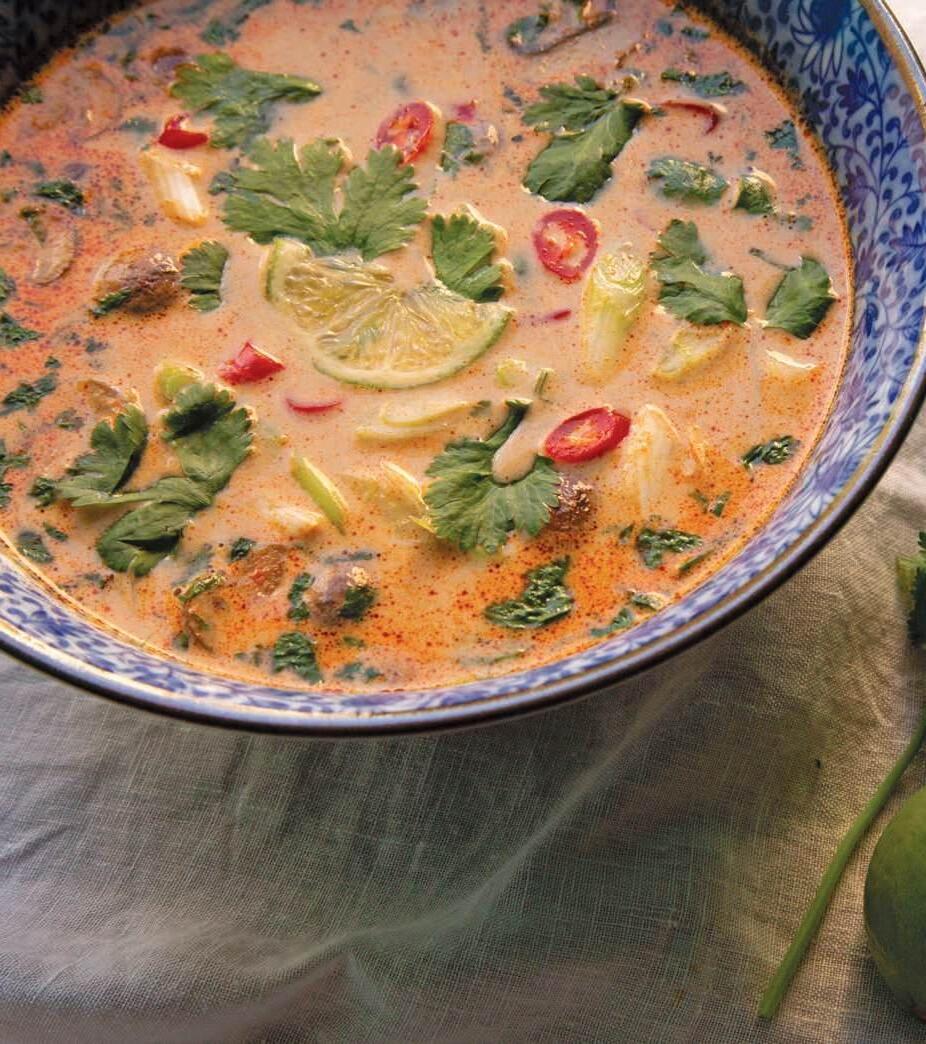
The classic Thai coconut soup is a fragrant blend of creamy coconut milk, tangy lime, earthy mushrooms, and aromatic lemongrass and galangal. For a vegetarian version, use tofu instead of chicken.
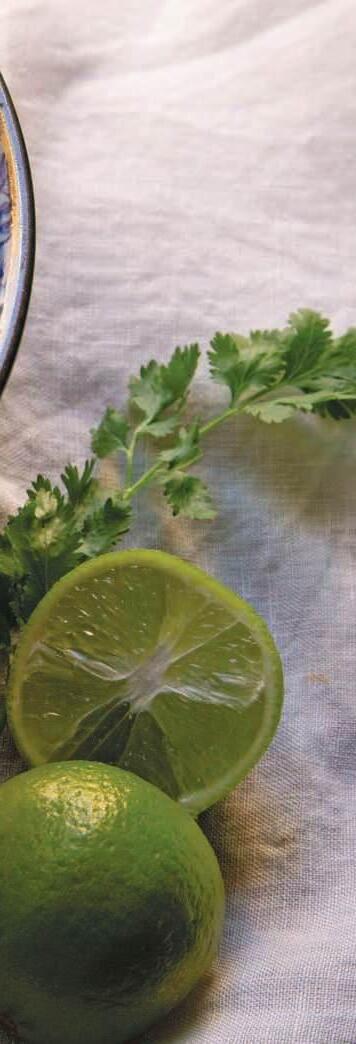
Serves 2-3
Preparation and cooking: 40 minutes
YOU WILL NEED:
2 chicken breasts, trimmed and chopped (or tofu)
4 garlic cloves
1 shallot
1 knob of fresh galangal
1 red chilli, sliced diagonally
1 stalk lemongrass
1 tablespoon rice wine vinegar
2 tablespoons Thai fish sauce
1l vegetable stock
400 ml coconut milk
1 teaspoon brown sugar juice of 1 lime
2 kaffir lime leaves
200g mushrooms
1 bunch spring onions, trimmed and sliced diagonally
1 handful fresh coriander, roughly shredded Thai chilli oil
1 tablespoon olive oil salt & pepper
TO GARNISH
lime slices • sliced red chilli
1. Trim the lemon grass stem and use a large wooden spoon to hammer and crush it so that it can release its flavours. Peel and chop the shallot, garlic and galangal. Slice the chili pepper diagonally.
2. Warm the olive oil in a pan, add the chopped aromatics and saute them for a few minutes. Add the chicken breast and stir fry for a few minutes. Now, stir in the rice vinegar and fish sauce and let the mixture cook for two minutes.
3. Stir in the vegetable stock and add the kaffir lime leaves. Bring the pot to the boil and then turn down the heat, cover the pot and let it simmer for 15 minutes.
4. Strain the broth into a clean pan and add the coconut milk. Simmer for a few minutes. Meanwhile, wipe the mushrooms and slice them up. Add them to the pot and cook them for approximately five minutes.
5. Turn off the heat. Squeeze in the lime juice and add the sugar. Stir in the chopped spring onion and coriander and season to taste.
6. Serve the soup in deep bowls garnished with lime slices and sliced red chilli.


Nestled along the shimmering waters of St. George’s Bay, Bayview Restaurant at The Verdi St George’s Bay Marina invites families and friends to indulge in an elevated Sunday buffet experience. The recent revival of this iconic Sunday lunch has sparked excitement, promising culinary artistry, live entertainment, and a warm, welcoming ambiance for all ages.
Imagine a bright afternoon on Bayview’s spacious terrace, where the tranquil Mediterranean provides a striking backdrop to a feast that celebrates the art of Mediterranean-inspired cuisine. Guests are greeted with an unlimited selection of water, soft drinks, and juices, setting a tone of casual elegance. Inside, the soothing sounds of live music by Richard Edwards enhance the setting, creating a sophisticated atmosphere that appeals to couples, families, and groups celebrating special occasions.
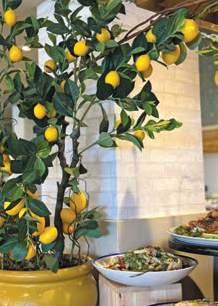
What Awaits You at Bayview’s Sunday Buffet Bayview’s Sunday buffet is a journey through flavours, where every course is crafted to delight the palate. From a selection of antipasti, fresh salads, and hearty soups to indulgent pasta dishes and freshly carved meats, the buffet offers endless options to savour. For dessert, a spread of fine cheeses and exquisite sweets rounds off the meal.
For families, the experience is made even more enjoyable with Bayview’s dedicated children’s animation. Professional animators lead activities like face painting, mini-golf, and balloon art, giving parents time to relax while little ones explore and play. For groups of ten or more celebrating milestones, Bayview adds a personal touch with a complimentary customisable cake, making the occasion truly unforgettable.
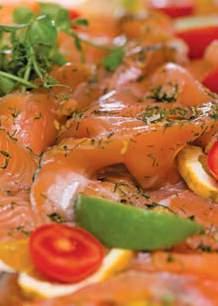
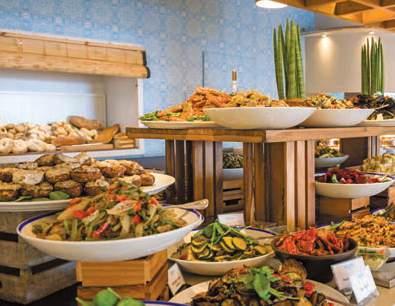



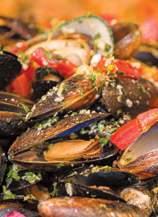
Plan Your Sunday Escape
The Sunday Buffet Lunch is served from 12:30 pm to 3:00 pm. Reservations are recommended as seating is limited, with pricing as follows: Adults at €36.50, Teens (13-17) at €28.00, Children (6-12) at €15.00, and Children under 5 dining for free. Complimentary underground parking (subject to availability) adds convenience, and the Bayview team is ready to create an experience you’ll want to relive each weekend.
Contact Us to Reserve Your Table
Be a part of the Bayview experience by reserving your place today. For additional information or to make a reservation, call +356 23 70 2 000 or contact us via email at team.restbar.sgb@verdihotels.com. Let Bayview’s ambiance, cuisine, and unmatched location transform your Sunday into a celebration of Mediterranean elegance.

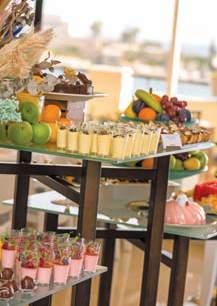

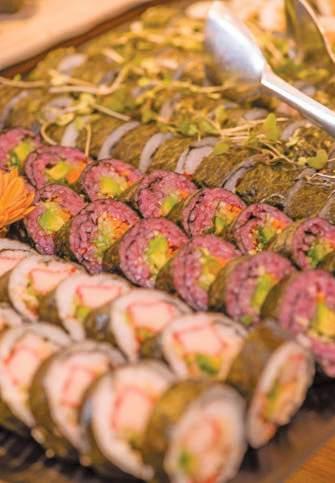



As autumn arrives, trees fill with rich, ruby-red pomegranates, a fruit steeped in centuries of symbolism and tradition. The “jewel of autumn” has represented everything from prosperity to rebirth, finding its way into rituals, family gatherings, and recipes. With their burst of vibrant colour and sweet-tart taste, pomegranates bring brightness, texture, and seasonal flavour to your table.
Acrosscultures and religions, pomegranates are seen as a symbol of beauty, eternal life and fertility.
According to Ancient Iranian Christianity, the pomegranate is said to have been found in the Garden of Eden. Rather than the apple, the pomegranate was believed to be the forbidden fruit in the Book of Genesis.
In Greek mythology, the pomegranate is a symbol of fertility and abundance. The story of Persephone’s abduction by the lord of the underworld is a metaphor for the natural cycle of growth, dormancy and regeneration.
In Ancient Rome, newlywed women wore crowns woven from pomegranate leaves, and the juice of pomegranates was used to treat infertility.
In the Song of Solomon, the cheeks of a bride behind her veil are likened to two halves of a pomegranate.
The pomegranate is native to the region from modernday Iran to northern India, and is now cultivated throughout the Middle East, the Mediterranean, and on the West coast of America.
Pomegranates were among the first fruit cultivated, along with vines and figs, beginning in Asia Minor. When they founded Carthage, the Phoenicians brought pomegranates to the African continent.
Afghanistan has more varieties of pomegranate trees than anywhere else in the world.


Sweet, tart, crunchy, and grainy, this salad is a satisfying mouthful. Serve it as a standalone light meal, or as a side dish with meat.
Serves 8 to 10
YOU WILL NEED:
2 broccoli heads
1 large bunch of parsley
1 bunch of mint
100g toasted pine nuts
2 cups of pomegranate arils
150g couscous
FOR THE DRESSING:
juice of half a lemon
4 tablespoons pomegranate molasses
4 tablespoons of extra-virgin olive oil salt to taste
1. Steam the cousous until it is cooked, then fluff it up with a fork and set it aside to cool down.
2. Blanche the whole broccoli heads for 90 seconds in freshly boiled water and then immediately transfer them to a bowl filled with ice and water to stop them cooking.
3. Drain the broccoli well and chop it finely. Transfer this to a salad bowl.
4. Wash the fresh herbs and pat them dry. Chop them finely and mix them into the broccoli. Add the pomegranate arils and couscous and stir.
5. Make the dressing by lightly whipping the extra-virgin olive oil with the lemon juice and pomegranate molasses. Drizzle the dressing over the salad and season to taste with the salt.
6. Plate the salad and serve it sprinkled with more pomegranates and pine nuts.
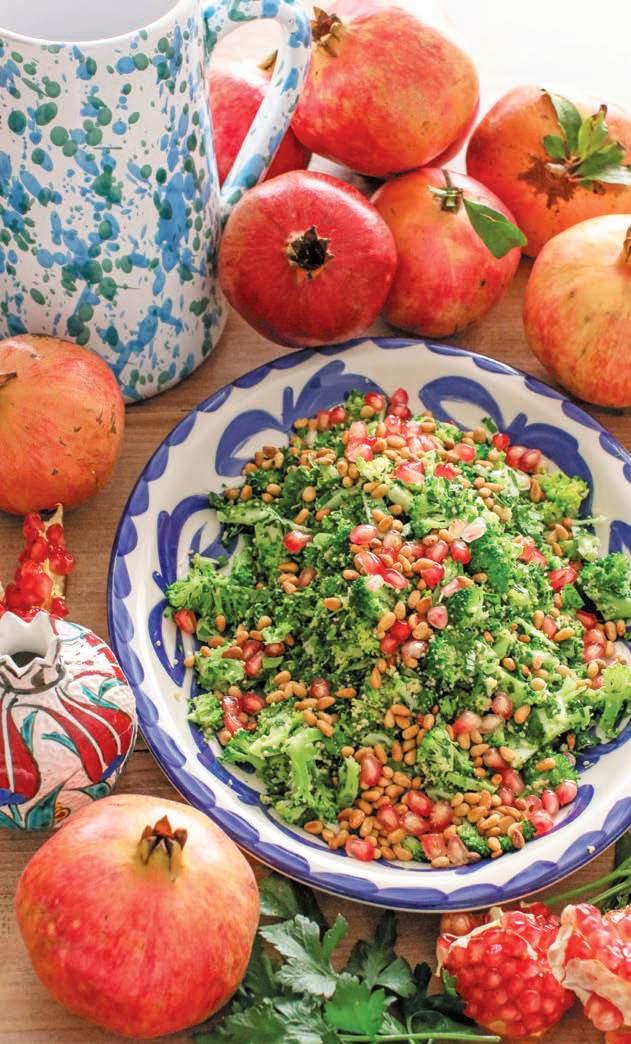
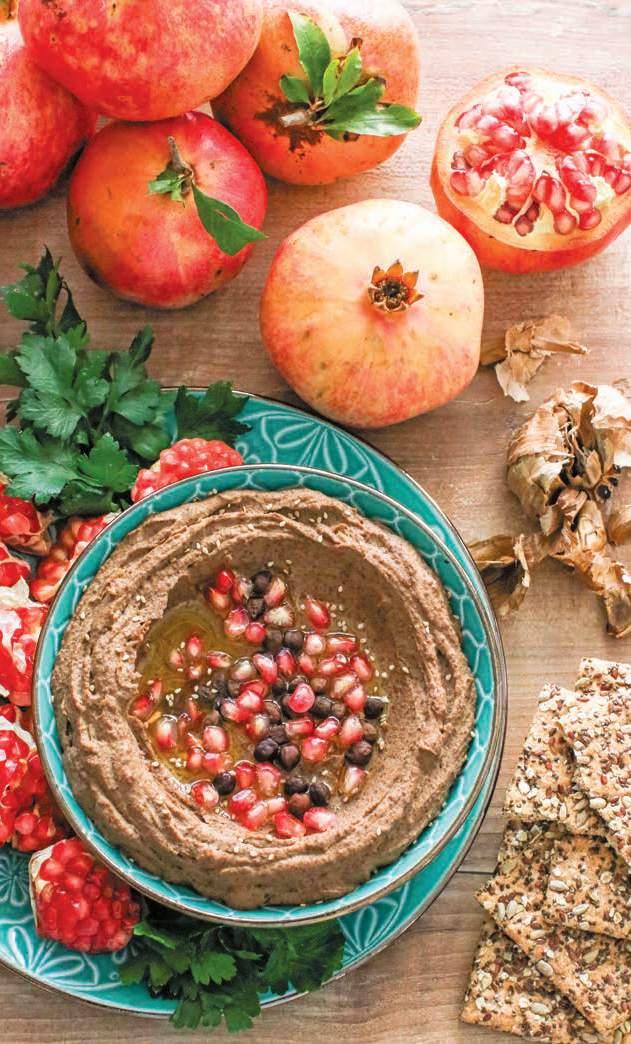
Hummus is perfect for a snack or starter. It stores well in the fridge, and can be served at a moment’s notice with freshly cut vegetable sticks, or warm flat bread.
YOU WILL NEED:
450g cooked chickpeas
60g tahini
100g olive oil
1 piece black garlic
1 teaspoon sea salt
¼ teaspoon ground cumin
½ teaspoon sumac
5 ice cubes
1. Place all the ingredients into a blending bowl and blitz them together until you have a smooth paste.
2. Add the ice cubes as you blend. This will help to avoid the mixture overheating and will include moisture to help loosen the paste. It should be thick enough to shap with a spoon, but not stiff, and not at all runny.
3. To serve, drizzle the hummus with olive oil, some cooked black chick peas, a drizzle of pomegranate molasses, some pomegranate arils and a sprinkle of sesame seeds
Serves 2
YOU WILL NEED:
4 slices of bread of your choice
2 eggs
4 tablespoons milk
½ a vanilla pod
a few drops rose water
2 tablespoons butter
cream cheese
sliced dried figs
goji berries
dried white mulberries
chopped pistachios pomegranate arils
icing sugar
orange zest
1. Prepare the bread slices on a plate. Beat the eggs in a bowl and stir in the milk, vanilla, and rose water. You will need to work quickly, so place the bowl and plate close to the cooker.
2. Place a large pan on the heat and put in the butter. Tilt the pan gently as the butter melts, so that the base is coated.
3. Now, dip the slices of bread into the egg mixture, taking care to coat both sides, and lightly fry them on both sides until they turn golden.
4. Stack two slices of bread onto each serving plate, add a large tablespoonful of cream cheese onto the top slice. Grate some orange zest onto the bread, then top up with the dried fruits, nuts and pomegranates. Sprinkle with icing sugar or maple syrup, and serve at once.

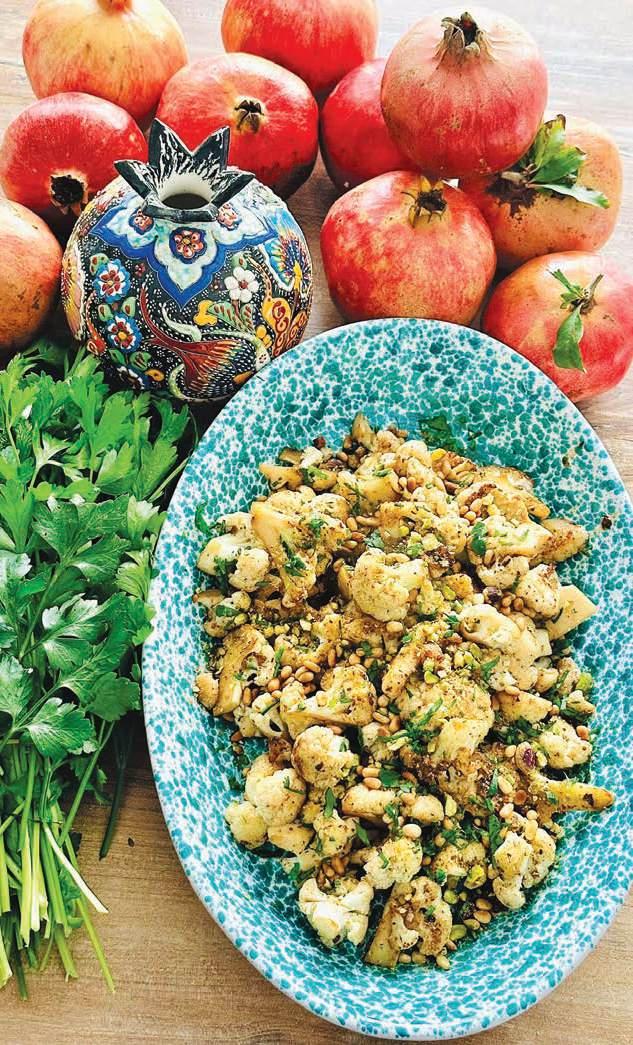
Aromatic spices infuse this otherwise simple dish with warming, comforting flavour. This can be served warm or cold.
Serves 6
YOU WILL NEED:
1 large cauliflower
a sprinkle of ground cloves
1 pinch of cinnamon
¼ teaspoon coriander
¼ teaspoon ground cumin
1 teaspoon whole cumin seeds
a sprinkle of nutmeg
a sprinkle of allspice
black pepper and salt to taste
2 tablespoon of butter
4 tablespoon pomegranate molasses
TO SERVE: toasted pine nuts
crushed pistachios
chopped parsley
1. Cut the cauliflower into very small florettes.
2. In a very large skillet, melt the butter, then add the florettes and the spices. Stir fry over high heat for about 8 minutes. The cauliflower should still be very crunchy.
3. Turn off the heat and stir in the pomegranate molasses.
4. Spoon the mixture onto a platter and sprinkle it with the nuts and parsley.

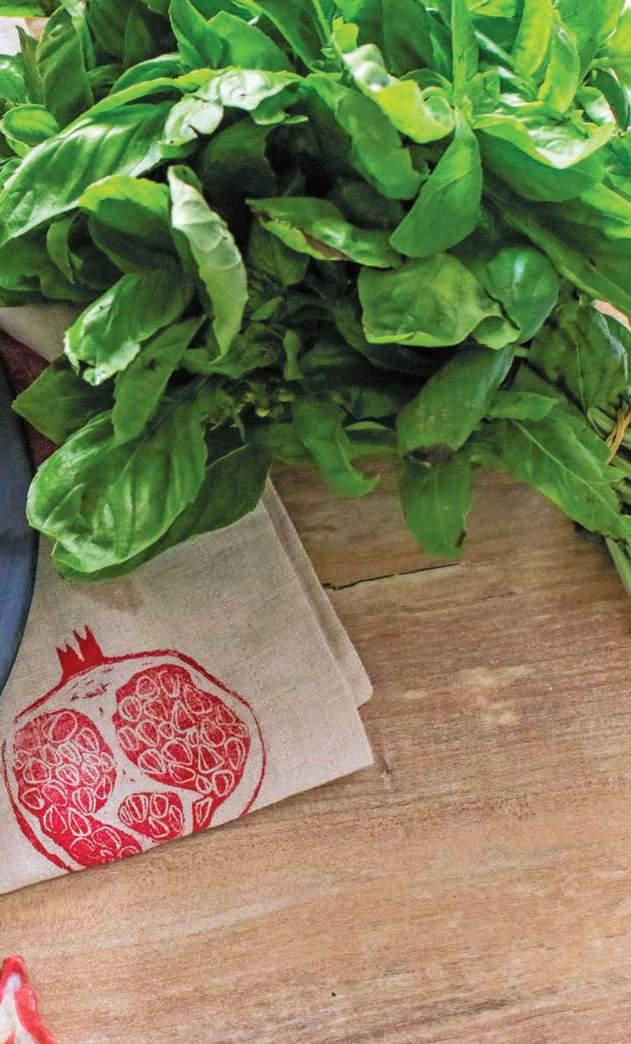

YOU WILL NEED:
2 avocados
some salad greens of your choice 150g feta cheese
pomegranate arils
chickpeas (I used black ones)
8 basil leaves
poppy seeds smoked sea salt
avocado oil
1. Peel, destone, and slice up the avocados. Rinse the greens and shake off excess water.
2. Dice the feta and finely slice the basil leaves.
3. Toss all the ingredients together in a large serving bowl, drizzle with avocado oil, season with the smoked sea salt, and serve immediately.
This one is for those who already brew kombucha at home. It’s kombucha flavoured with fresh blueberries and pomegranates for the second fermentation. However, you could also buy a natural kombucha, pour it into a jar, add pomegranates and blueberries, and keep the mixture in the fridge for a couple of days. The fruit will seep into the drink and will not only colour the kombucha but will flavour it too. If you want to make your own kombucha, here’s how it’s done. “Scoby” in the list of ingredients stands for “symbiotic culture of bacteria and yeast”. This facilitates the fermentation process, converting the sweet tea into kombucha
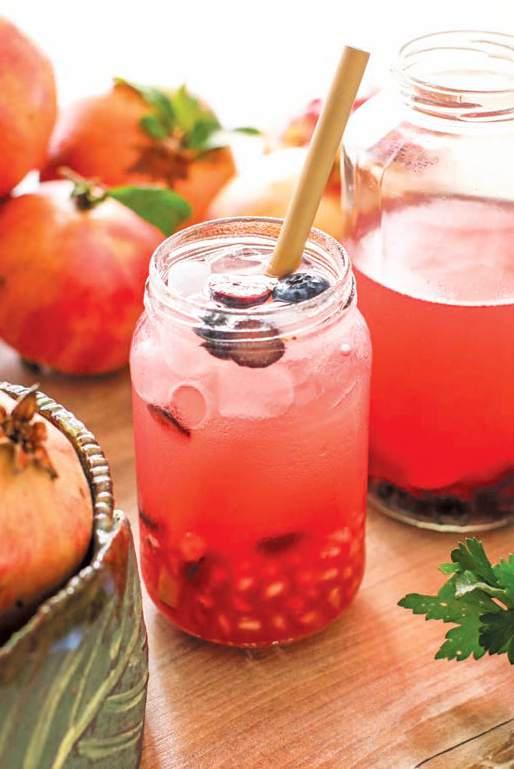
YOU WILL NEED:
1.8l water
2 teaspoons loose leaf green tea
2 teaspoons loose leaf black tea granulated sugar scoby, plus 100-200ml starter liquid (reserved from an earlier fermentation)
1. Boil the water, put it into a pan and add the tea and sugar. Stir the mixture until the sugar dissolves and set the pan aside for 10 minutes for the tea to infuse.
2. Strain the liquid to remove the tea leaves and set the liquid aside to cool down completely.
3. Pour the infusion into a sterilised 2.5 litre glass jar, add the scoby and the starter liquid. There should be an air gap at the top.
4. Cover the top of the jar with a clean dish cloth and wrap a rubber band around the neck of the jar to hold the cloth in place. Place the jar where it can ferment for a couple of weeks. It should remain at room temperature and not be exposed to sunlight or heat. Don’t store it in a cupboard as it will need air.
5. After a week, taste the kombucha each day as it will become progressively acidic. When it’s to your taste, set aside the scoby and reserve some of the liquid for the next time you brew kombucha.
6. At this point, you can store the kombucha as it is or add fruit and bottle it up. Let the fruit ferment for a few days before serving.
7. You can store kombucha in your friedge for up to three months.
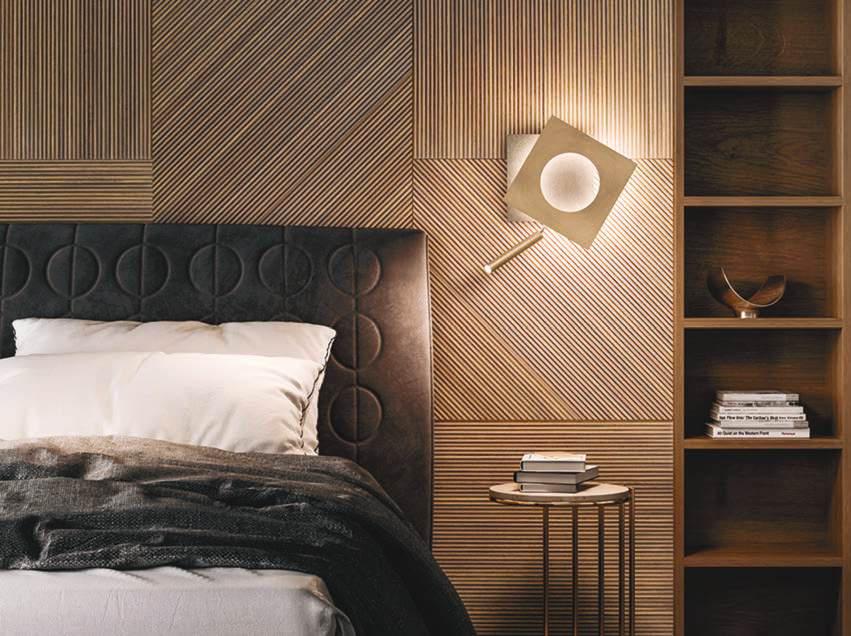

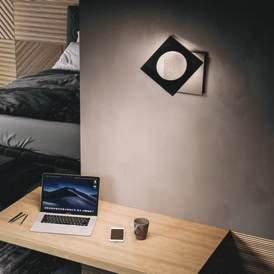




The backyard has been raised and the wall between the kitchn and dining areas has been opened up, creating a seamless indooroutdoor flow. Natural light floods the interior, complemented by lighting from OK Home and Elektra.

Transforming a 20th century Sliema townhouse for contemporary family life
Interior design: Caroline Ciantar-Barbara Photography: Jean Marc Zerafa



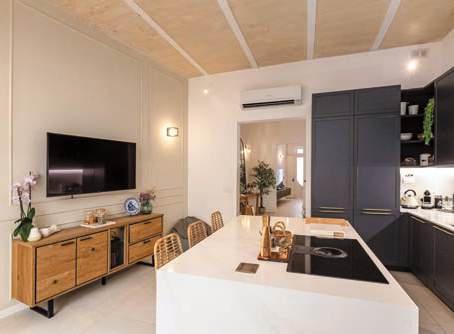
After decades of seeing old houses torn down, it’s refreshing to hear that a young family has renovated an old Sliema townhouse as their home. “The owners are a young, growing family. They wanted a home that is easy to maintain but retains the charm and heritage of the original house that they so love,” says Caroline Ciantar-Barbara, the interior designer who was commissioned to renovate the interior. “You’d be surprised at how many people would want to renovate a house like this by doing away with most of the traditional and more elaborate elements. Its features are typical of Sliema architecture, and include traditional elements like stone xorok and a beautiful carved limestone staircase.
At the time the house was originally built, each staircase step used to be freshly quarried. The process was labour-intensive, involving meticulous hand-chiseling. This required not just technical ability but also a deep understanding of the stone’s properties, ensuring that it would endure over time without cracking or breaking. “For this reason we kept the staircase in its natural stone finish
to make sure it gets the attention it deserves,” Caroline says. “The same goes for the sculpted limestone doorways which frame the doors so delicately.”
The house, very likely dating back to the early 20th century, is in Sliema’s urban conservation area and is surrounded by some of the most beautiful of the town’s Art Nouveau houses. It’s flooded with natural light, especially now it’s been renovated, and the new interior emphasises a seamless indoor-outdoor flow, elevating the once sunken yard which was at basement level.
The design brief was to create a light and bright familyfriendly space, while preserving and highlighting the house’s traditional Maltese architecural features. The interior designer drew inspiration from the natural materials and craftsmanship found in the original building, emphasising its features while introducing contemporary elements such as a dark blue, dramatic kitchen that provides a striking contrast to the otherwise neutral palette, grounding the design and adding depth, and neutral tones to keep the space feeling open and light.


“Neutral, earthy grey tones were the client’s colour preferences, so it was a matter of creating a balance in all the different elements. Maintaining a balance between the old and the new was essential. I tried my best to highlight the traditional features like xorok, the carved staircase, and the original doors without making the space feel dated or cluttered,” says Caroline. Cement tiles on the first floor landing were salvaged and reused, serving as a visual reminder of the house’s history. The ones that could not be used were repurposed, extending their life elsewhere, a running theme in this project which showcases a commitment to sustainability and preservation.
A complete overhaul of the house’s plumbing and electrical systems was needed to bring it up to contemporary standards and to accommodate new fittings such as air conditioning. Achieving this without compromising the building’s integrity is not easy, especially when you’re running services to and from the upper floors. But Caroline likes to look at this as an opportunity for design, rather than a challenge: “ For example, we created a curved wall in the ground floor hallway and on the upstairs landing and managed to hide the electrical and other pipework behind it. This only involved a singular penetration in a stone slab (xriek) to run the services from one floor to the next.”
The original wooden doors have been restored and some of them repurposed. For example, the pair of restored doors that previously led to the kitchen has been shifted to the pantry that the designer created, making it seem like it has always been there and giving the old doors a new life. “I never find justification for disposing of old joinery,” Caroline says. “I am a firm believer that older joinery is so robust it can endure for a few more centuries. The level of detail and design they used to go into would cost a fortune to recreate today.”

In the living area, the stone ceiling slabs (xorok) have been left exposed, a traditional design element that complements the newly redesigned interior.
Electrical and other pipework are hidden behind the new curved wall, avoiding the need to cut into the original stonework.


Discover the full range of sunscreens, decking, profiles and cladding modules for walls, ceilings and facades, designed to offer the look of natural wood, without requiring maintenance, thanks to a patented resin-shielded technology.
A1930s fireplace reminiscent of Malta’s colonial era was initially unwanted by the home owners, but Caroline explained that this is typical of early 20th century houses, especially in Sliema. “I managed to convince them that the fireplace is worth keeping,” she says. It is now a quaint feature in their son’s bedroom, adding historical depth to the contemporary room.
The original layout of the house has been largely left untouched. “Rather than making major structural changes, we focused on adapting and refining the more recent alterations to work to our advantage,” says the interior designer. “The main task was to optimise the available space while harmonising it with the new owners’ appreciation for a modern traditional aesthetic. We achieved this by installing wall panelling and a carefully designed kitchen, which helped to break up the impressive ceiling heights.” The design elements added layers of texture, creating a cosy and intimate atmosphere while maintaining the home’s elegant proportions.
A number of thoughtful structural changes were made to enhance the home’s functionality and comfort, ensuring a seamless blend with traditional aesthetics and making the home more adaptable and welcoming. “The most effective change was the elevation of the backyard to create a seamless indoor-outdoor flow,” Caroline says. This allowed natural light to flood in through the bespoke wooden garden door, whereas it would previously have been lost in the void at the back of the house. The further opening up of a wall between the kitchen and dining area expanded the interior space and allowed light from the backyard to flood through, creating a brighter and more inviting atmosphere. The remaining portion of the supporting wall was cleverly utilised to create the small pantry.
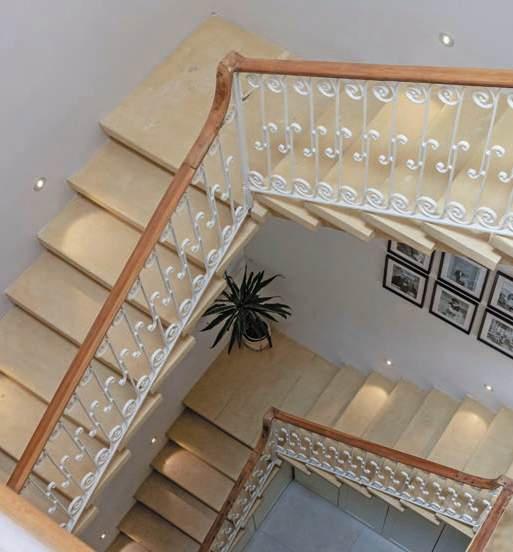

the
enabled
that
last for decades. At the time the house was built, each stone step would have been freshly quarried and chiseled by hand, ensuring it would endure over time without cracking or breaking.
A 1930s fireplace, reminiscent of Malta’s colonial era, is now a quaint feature in the son’s bedroom. Wall lights from ESS Ltd and Elektra Ltd complement the contemporary look.

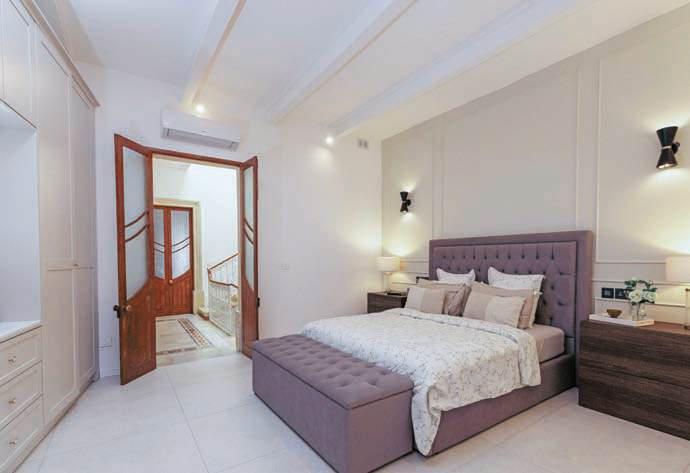
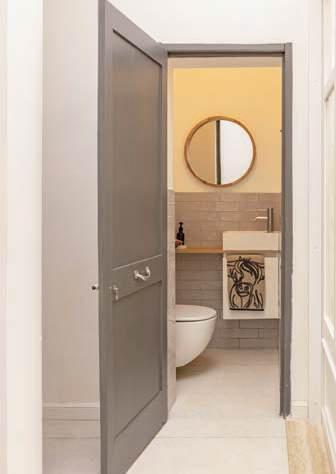
Storage was introduced under the ground floor staircase to keep up with the family’s needs while keeping the overall space tidy. The custom panelled cabinetry recedes from the stone staircase, ensuring that the architectural feature remains the focal point. An ensuite bathroom added to the young son’s bedroom provides him with privacy and eliminates the need to share the only other bathroom on the same floor, which is in the main bedroom. To further accommodate the family’s evolving needs, a new bedroom with an ensuite bathroom was constructed at roof level, serving as a guest room while also preparing for the eventual expansion of the family.
One significant setback was a delay by the cement tile supplier. Just two months before tiling was set to begin, the owners were told the tiles would not be ready on time which would have delayed the project by months. To keep on schedule, the owners decided to switch to a natural stone-colored ceramic tile instead. “It wasn’t our original choice, but it still fits seamlessly with the overall aesthetic,” Caroline says. “It evokes the look of traditional flagstones often found in townhouses, but with a modern twist and ease of maintenance.”
This project was a delicate dance between preservation and innovation. Through thoughtful design and a respectful approach to restoration, the final result is a bright, modern home that retains its traditional charm. “Renovating the house has not only given it new life but has allowed it to serve as a bridge between the past and present, offering comfort and character to the young family who now calls it home,” Caroline says. “It is always gratifying to see a historic house revived, extending its life for, hopefully, another century. Now, it is this family’s turn to leave their own personal mark on the house, adding a new chapter to its rich heritage.”

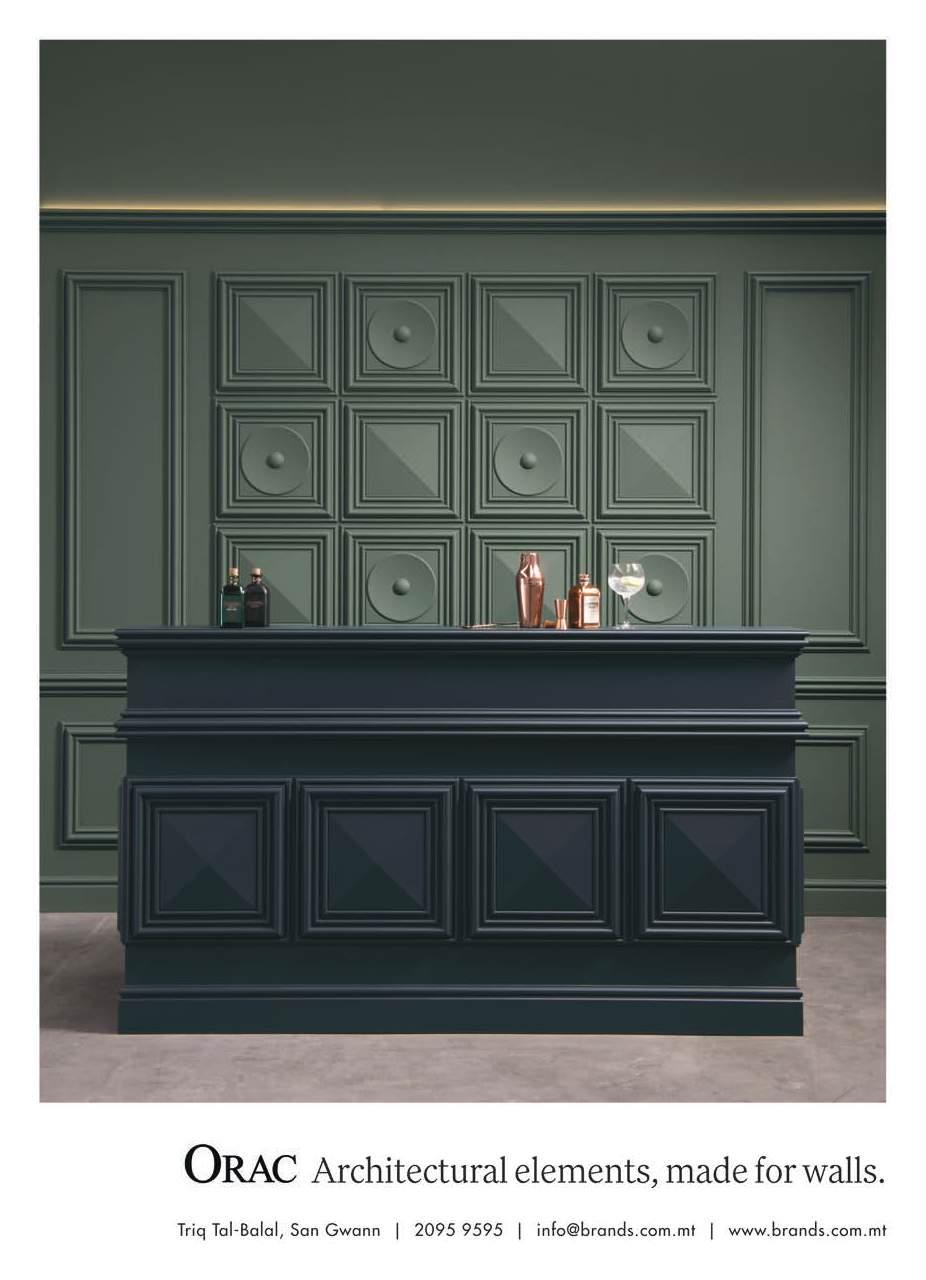
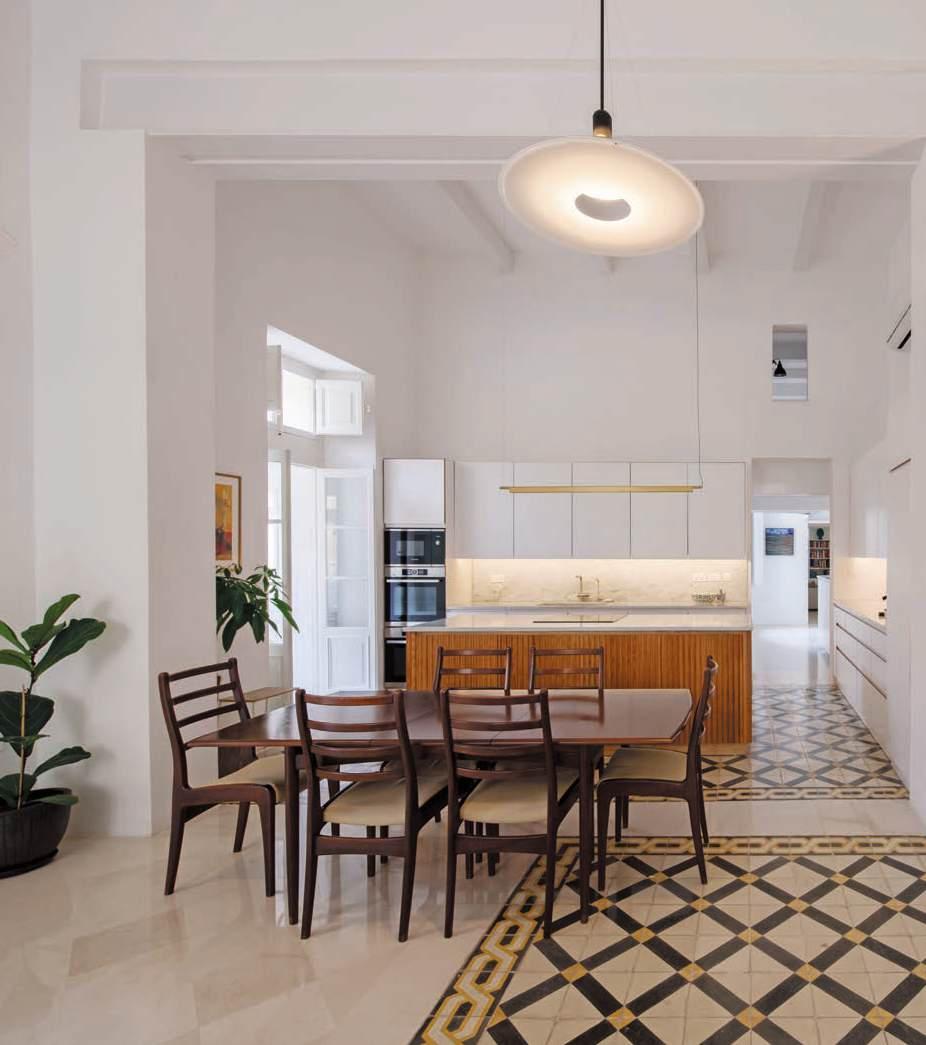
The articulation of the property demanded creative solutions and all services needed to be redone and upgraded. Contemporary fittings include a pellet stove supplied by Il Camino, air conditioning, and ceiling fans.
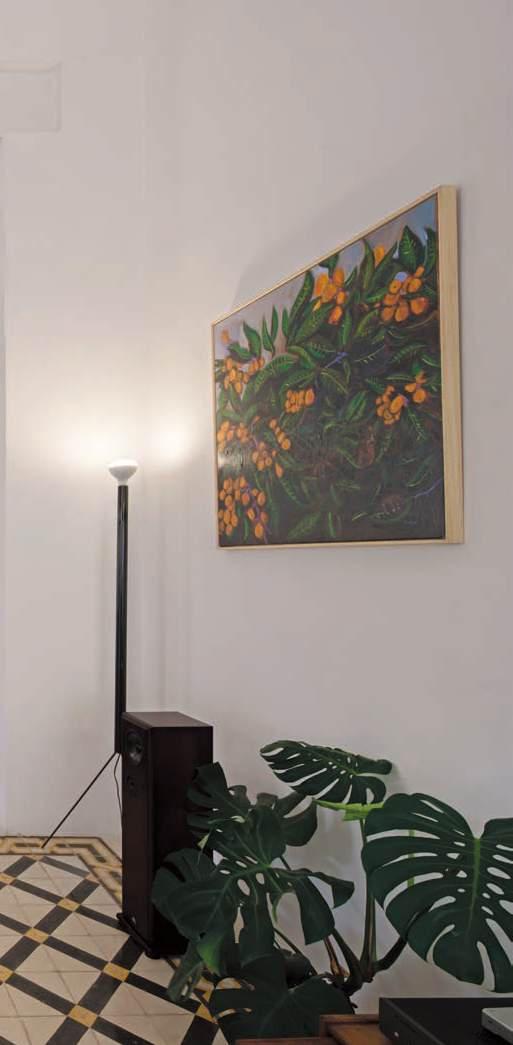
Architecture and interior design: Open Work Studio
Photography: Julian Vassallo
Premju Emanuele Luigi Galizia Award
Casa Ursula won the Best Interior Architecture award in this year’s edition of the relaunched Premju Emanuele Luigi Galizia, organized by Kamra tal-Periti. The jury, composed of Davide Macullo, Simonetta Cenci, Giuseppe Farris, Isabel Van Haute, and Thomas Coldefy, chose OpenWorkStudio’s Casa Ursula project because: “The design showcased an innovative response to the existing context, skilfully transforming the property’s fragmented layout into a cohesive living space. The thoughtful restoration reveals hidden structures and honours the building’s history by maximising light and connectivity…Overall, this project exemplifies a brilliant fusion of creativity, history and modern living setting a high standard for future architecture interiors.”

The thoughtful restoration reveals hidden structures and honours the building’s history by maximising light and connectivity.

When a young couple were planning their new home, they set their hearts on living in a contemporary interior within an old building with at least two bedrooms and two bathrooms and a kitchen and dining space where they could entertain or host events. A maisonette in a 200-year old building offered much potential but it needed complete redesign to make it habitable after it had been unoccupied for a decade or more. The building itself is in an urban conservation area, which imposes strict parameters on structural and aesthetic changes, so the expertise of Open Work Studio was invaluable in reshaping the interior and navigating the various planning rules.
“We were inspired by the building itself: by what we found on site and what we could reuse. We were also greatly inspired by our client’s positive energy and vision. The property was unique from the start and the main aim was to improve upon the existing structure and to accentuate its features through our design. We wanted the interior to feel Maltese, incorporating its historic elements, while also creating a young and modern home for its residents. It is this contrast that always interested us, and what we believe will keep the project ageless,” says Francesca Cremona, lead architect on the Casa Ursula project.
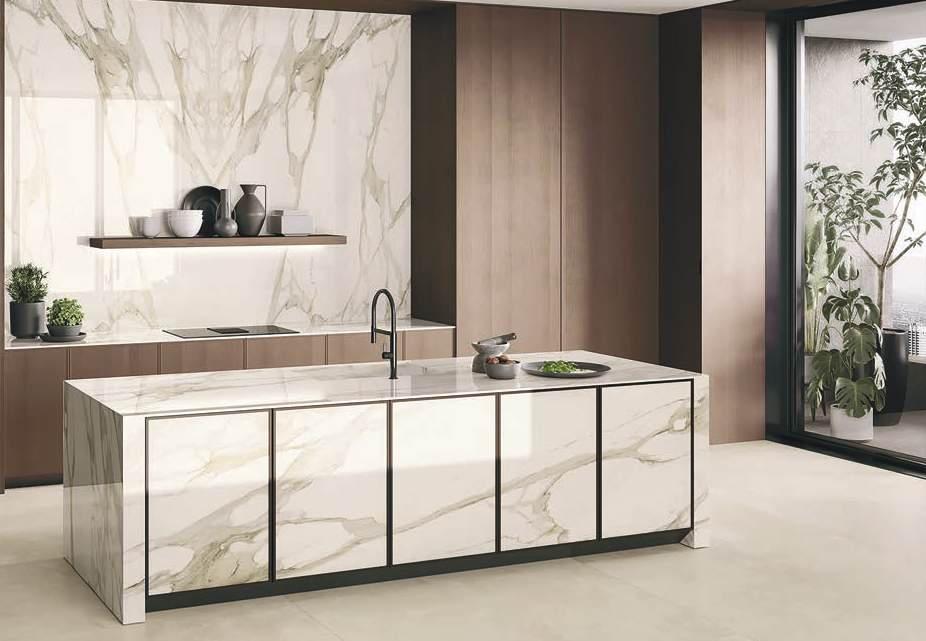


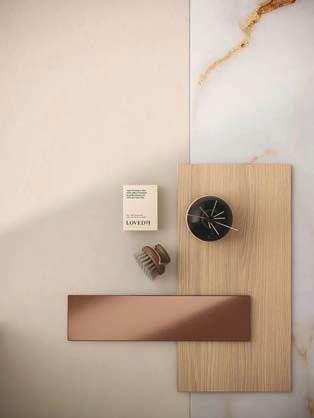

“We believe the building dates back to the late 19 th century,” says Joanna Spiteri Staines, Conservation Architect and Founding Partner at OpenWorkStudio. “It was possibly built by the British Royal Engineers since the stereotomy of the arches and size of the stones is very similar to that of the Naval Bakery in Birgu. During restoration works we found 1881 inscribed on one of the façade stones
The original cement tiles have been retained and restored by Compass Floor Care, grounding the interior in tradition. The open plan kitchen in a contemporary design is anchored by a bespoke island topped with marble from Absolute, who also supplied the countertops and backsplash.


The maisonette’s configuration is long and narrow, so bringing natural light and ventilation to the centre of the property was crucial. Strategically-placed lighting supplied by ESS Ltd complements the natural light that now flows through the space
which further corroborates our theory. “A crucial aspect when rehabilitating an existing building are the numerous restrictions, such as limitations on changes to the façade in an urban conservation area, the restricted common shafts when studying ways to bring morelight and ventilation into the property, and fitting in contemporary services without using soffits,” Joanna says.
The long and narrow property’s interior now flows smoothly from one end to the other through a sequence of interesting and luminous spaces

Structurally, the building was in a decent condition apart from the roof and some damage to the timber beams, which have been repaired. Apart from one of the closed balconies and the new windows not on the façades, all the original timber apertures have been restored. “We also reused some of the beautiful internal timber Maltese librett type folding doors,” says Joanna.
The façade was in reasonably good shape, however at ground floor level an oil paint was used which is very difficult to remove. The property formed part of a “jig saw puzzle” of third-party properties. In all there were seven to visit and contend with when designing the structural alterations – a challenge, particularly during the first site investigations. “One adjacent neighbouring building which had a large and precarious masonry staircase was in worse disrepair and we had to take particular care,” says Joanna. “Together with our structural engineer Lara Brincat we allowed the steel mezzanine structure to have a dual role and also help reinforce this neighbouring property.”

Thanks to the internal height of the property, OpenWorkStudio was able to create a mezzanine and a double height space. Ruben Abela Wrought Iron Work supplied the internal steel works.
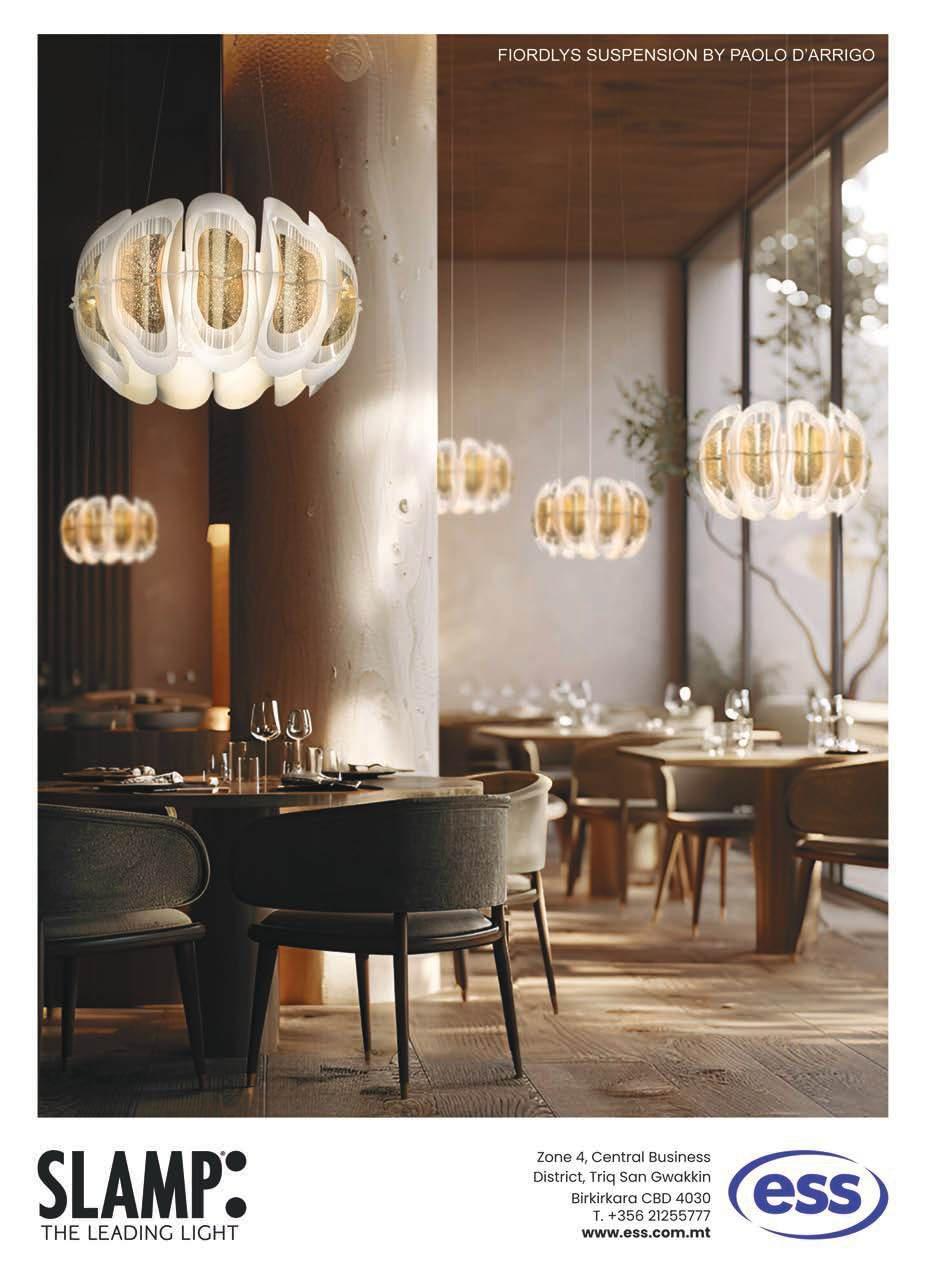


A pellet stove by Il Camino provides warmth. Vertically-ribbed cladding by Brands International Ltd adds visual texture and accents the curvature of the wall below the mezzanine. The same cladding was used to create an interesting backdrop in the bathroom.
Inside, lighting and services were minimal, and there was no kitchen. There were problems with the drains-water supply and electrics, the only bathroom probably dated back to the 1980s, and all services needed to be redone and upgraded, including air conditioning, a pellet stove and ceiling fans. Some of the cement tile flooring was in good condition and could be preserved. The articulation of the property demanded creative solutions because, as was typical in their time, bathrooms were extremely small and therefore unsuited to contemporary needs.
The maisonette’s configuration is long and narrow, so bringing light and ventilation to the centre of the property was crucial. The most important design priority was to introduce light into the central area. The second priority was to exploit the double height space and introduce a second bedroom. From the outset the architects decided to subtly show all the structural alterations and contrast the new with the old, juxtaposing the old structure with the interventions using contemporary materials such as steel and glass.





Blacksmith, Metal Fabrication, Steel Fabrication, Welding, Wrought Iron Fence Installation, Wrought Iron Fence Repair. Your Vision, Forged in Iron.

“When redesigning the layout we had to create very private spaces, such as the bedrooms, bathrooms, and study areas, with restricted sources of available light and a challenging plot configuration,” Francesca says. We used a variety of partitions and translucent materials to create privacy where it’s needed and to improve the spatial layout from a design point of view.”
The architects opened up the front three rooms to create an open kitchen-dining and living area and, thanks to the internal height of the property, were able to create a mezzanine and a double height space, connecting it through the existing spiral staircase. “The exciting part of redefining double height spaces is that it allows the user to experience an existing building from new and interesting viewpoint,” says Francesca. “The kitchen now is really the fulcrum of the entire home as the owners are keen cooks.”
There were promising elements in the property, particularly a very beautiful large masonry spiral stone staircase to the roof, which became a key connection to reach the roof and the new mezzanine. Other than their peeling paintwork, both staircases were in mostly good condition and needed little more than paint stripping to bring them back to their original stone finish.
The back part of the property has been drastically altered, dividing the rooms both by configuration and the choice of materials. When removing one of the existing partitions in the back of the property the design team discovered a timber A-frame structure that helps support the third-party property above. Instead of covering it up again, they integrated it into a new partition between what are now the main bedroom and the TV area, where it makes for a unique element.

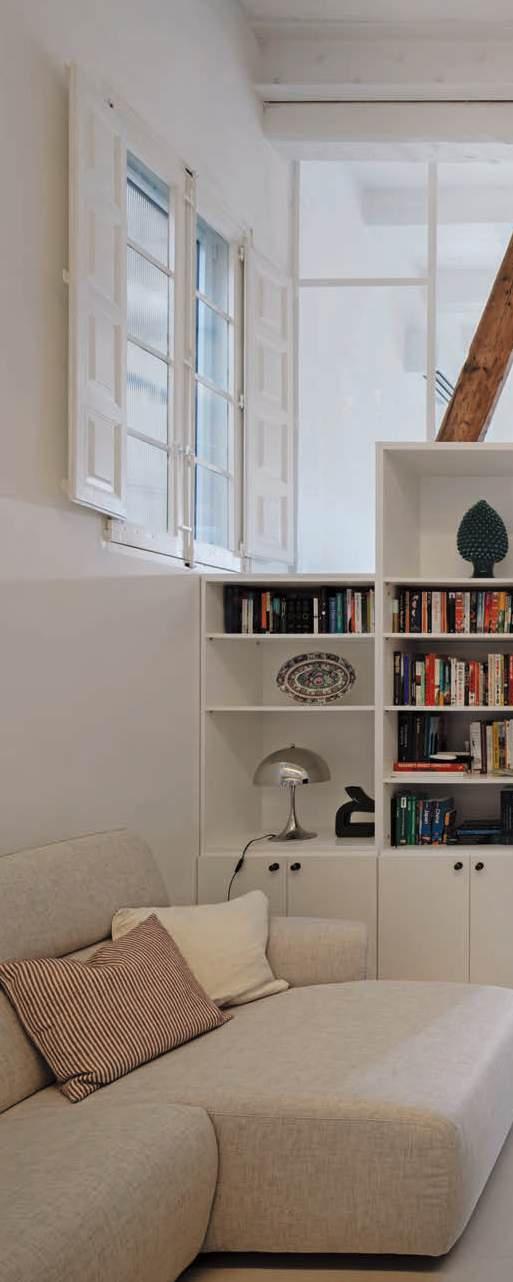

“We used a variety of partitions and translucent materials to create privacy where it’s needed and to improve the spatial layout”

The long and narrow property’s interior now flows smoothly from one end to the other through a sequence of interesting and luminous spaces, where each part of the route has been transformed into a space with a purpose. For example, the passageway from the kitchen through to the back sitting area is also a study and reading area. It also conceals a guest bathroom and access to the mezzanine. Each space is individualised through the use of different textures and shapes such as the curved structure and fitted joinery, while the neutral tones allow each space to flow seamlessly with the next.
“When choosing to keep a large portion of the existing cement tiles, we found a natural stone to match their background colour to create continuity throughout the property and we echoed some of the existing tile patterns and shapes – such as the diagonal pattern of the tiles – in the new paving pattern on the landing as well as in the railing design. This creates a dialogue between the additions and alterations to the existing fabric and a link to the past” Francesca says.
“We are very pleased about the result and privileged that the owners entrusted us with this project. Their trust and involvement were key elements in the outcome of the renovation and allowed us the freedom to explore and develop a successful project that the owners are now truly enjoying.”
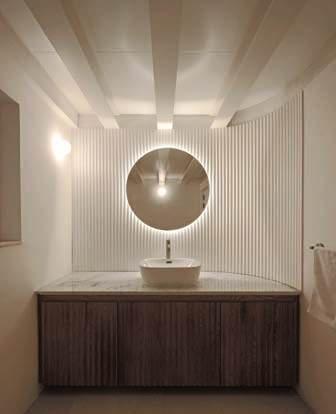





Each canvas is a window into the room’s interior world, their collective display an artwork in its own right.
Meeting Lydia Cecil is a delight. She’s refreshingly unpretentious and unassuming. A representational artist who lives and works between the UK and Malta, she has exhibited in both places as well as in Florence and Samoa. Her work is based on studies from life. She delves into the character of a portrait sitter, arranges contemporary still lives, and uses the alternating backdrops of the UK and Malta for her figurative work, capturing ordinary, unscripted moments with an originality away from idealisation or objectification.
Cecil’s latest exhibition, A Room with a View, opened recently in Valletta. Unlike the room of the famous E.M. Forster book with its sun-soaked Italian inferences, this room is set in a house near the Dorset coast in southern England. It is charming in a dilapidated way, with eaves
that slope from the single window whose light doesn’t quite penetrate to the back of the room.
The old wooden furniture has seen better days, and the fireplace feels forgotten. Dusty books and mirrors speak of old status, while taped up paper drawings, of young eccentricity. Even while the wall paint cracks, its colour shifts under the light sources – from a cool, hazy blue from the soft British sun to a deeper, warm green under the artificial lamps.
A single figure inhabits each canvas. Around the room in the paintings, there are glances between them, into the mirrors, to the viewer. Each canvas is a window into the room’s interior world, their collective display an artwork in its own right. Standing amid the six large paintings, the room in the paintings encases you, just as does the room in

New


Standing amid the six large paintings, the room in the paintings encases you, just as does the room in which you, the viewer, stands.
which you, the viewer, stands. Each of the female-strong cast subtlety subverts the norm of how women are portrayed in traditional art. The only male is nude.
At first elusive, a detail soon catches the eye. The presence in the room in the paintings is not solely human. There are grey pigeons claiming the space as their own, sitting proprietorially beneath the sloping ceiling, tucked into a corner of a top shelf, fluttering above a figure reclining on a green armchair, clutching the top of a privacy dressing screen, and a proverbial pigeon pair pecking at the floor.
There is a dove too, its statuesque posture an elegant contrast to the casual contortion of the statuette next to which it stands.
Slight shifts in perception can reveal our deep-rooted assumptions. The flies in our eyes. Or planks, if you prefer the Bible to Catch-22. After all, isn’t a dove a white pigeon?
A Room with a View opened at Risette Restaurant at 81 Old Theatre Street, Valletta on 24th October 2024. It will remain on view until April 2025.
About the Artist Lydia Cecil studied at the London Atelier of Representational Art. She takes portrait, figurative and still life commissions, and currently works as a tutor for Raw Umber Studios and College Arts. She is represented by Cicek Gallery in London. www.lydiacecil.co.uk


The Snoopy Table Lamp by Flos - designed by Achille and Pier Giacomo Castiglioni in 1967, provides direct light through its enamelled metal reflector and rests on a white Carrara marble base. Combining classic materials and bold design, the new Navy Blue finish retains its iconic playful shape while adding a fresh, modern touch. The Snoopy lamp remains a timeless piece, enhancing any interior with style and character. Available at the ESS showroom in Mriehel, Birkirkara.
Satariano’s ceramic wood look collections. Love the warmth and charm of wood but need something practical? Check out Satariano’s ceramic wood look collections - it’s the perfect blend of cosy vibes, authentic style, and practicality. Satariano, 122 Msida Valley Road, Birkirkara. Tel. 2149 2149.
Exciting News from Satariano! We’re thrilled to announce our partnership with Visobath, a leader in stylish and functional bathroom furniture. Transform your bathroom with their sleek, elegant designs that combine smart storage with a touch of warmth and sophistication. Available exclusively from Satariano, 122 Msida Valley Road, Birkirkara. Tel 2149 2149.


Bel DOK Malta by Meridiana is made from selected estate-grown Syrah grapes. It has a ruby-red colour with a purple rim; smoky aromas, scents of ripe berry fruits with hints of spices; and a complex, cherry-blackberry flavour with an enduring finish. Part of the wine is aged for six months in French oak barrique (225 lt) while a part is preserved in stainless steel to maintain freshness. After blending and bottling, the wine rests for a further six months in the bottle. More info on www.meridiana.com.mt Trade Enquiries www.srausi.com

Cut Cut Carpets. As the temperatures drop, it’s the perfect time to add warmth and style to your space with Cut Cut carpets. With a wide range of textures, colours, and designs, you’re sure to find the perfect match for any room. Plus, enjoy the convenience of custom cuts tailored to fit your space perfectly. Create the ultimate cosy atmosphere this season with Cut Cut carpets exclusively from Satariano, 122 Msida Valley Road, Birkirkara. Tel. 2149 2149.
We will be back in December 2024 with The Malta Independent on Sunday. For advertising, contact Sean Ellul on +356 7921 0705 sellul@independent.com.mt

